ICOM orporated 298700 VHF Marine Transceiver User Manual
ICOM Incorporated VHF Marine Transceiver Users Manual
Users Manual
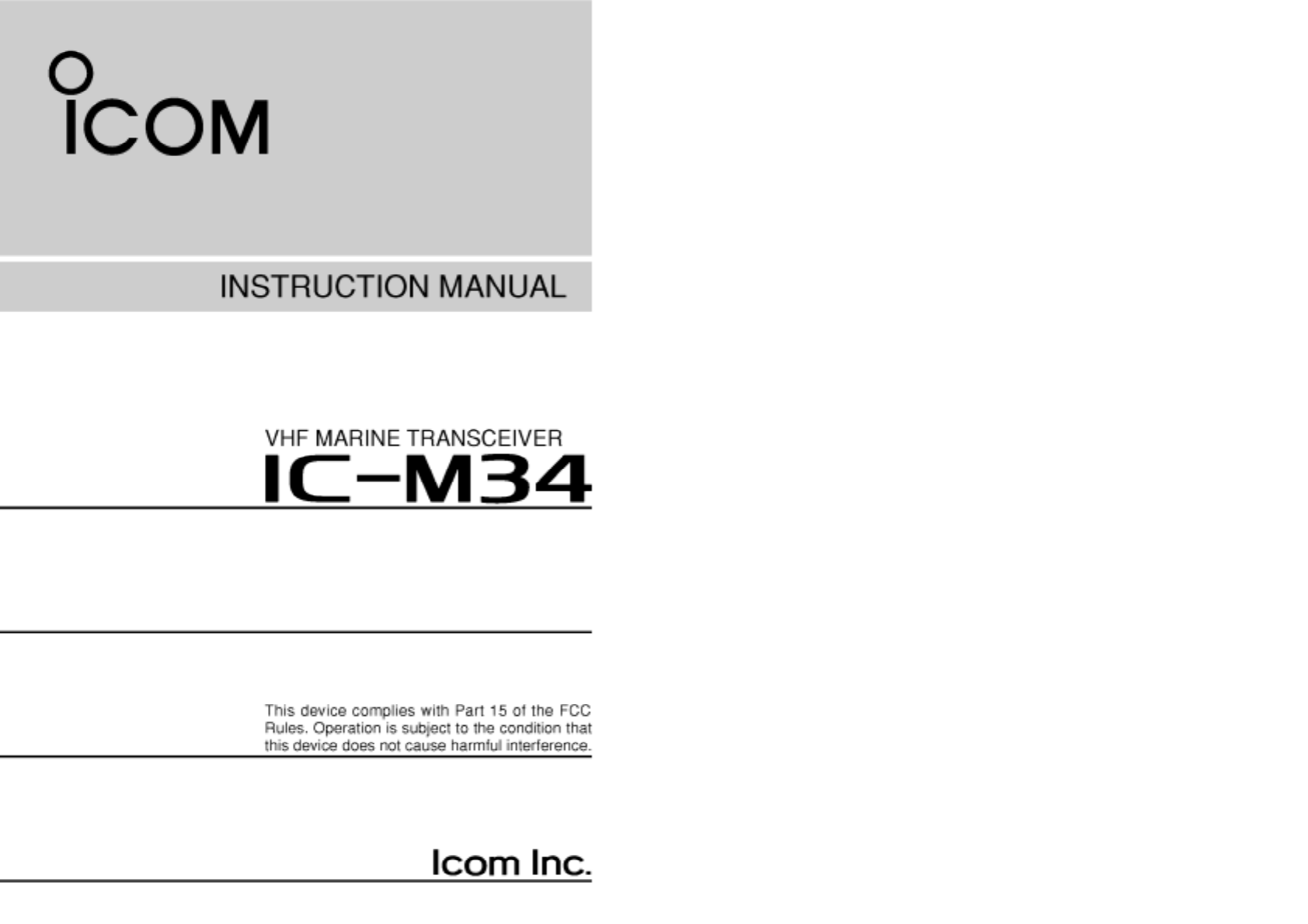
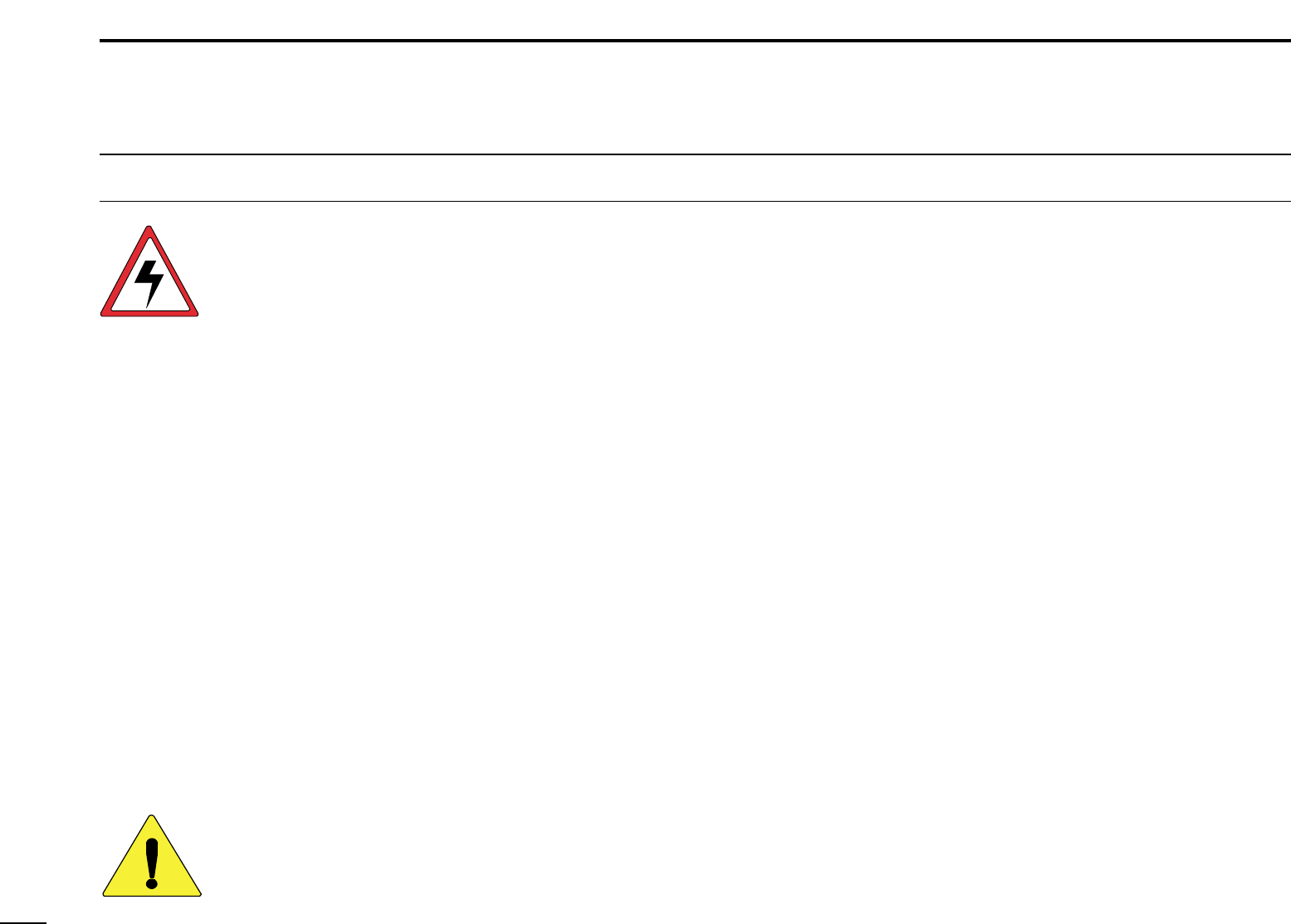
i
SAFETY TRAINING INFORMATION
Your Icom radio generates RF electromagnetic energy during
transmit mode. This radio is designed for and classified as
“Occupational Use Only”, meaning it must be used only during
the course of employment by individuals aware of the haz-
ards, and the ways to minimize such hazards. This radio is
NOT intended for use by the “General Population” in an un-
controlled environment.
This radio has been evaluated for compliance at the distance of 2.5 cm with
the FCC RF exposure limits for “Occupational Use Only”. In addition, your Icom
radio complies with the following Standards and Guidelines with regard to RF
energy and electromagnetic energy levels and evaluation of such levels for ex-
posure to humans:
• FCC OET Bulletin 65 Edition 97-01 Supplement C, Evaluating Compliance
with FCC Guidelines for Human Exposure to Radio Frequency Electro-
magnetic Fields.
• American National Standards Institute (C95.1-1992), IEEE Standard for
Safety Levels with Respect to Human Exposure to Radio Frequency Elec-
tromagnetic Fields, 3 kHz to 300 GHz.
• American National Standards Institute (C95.3-1992), IEEE Recommended
Practice for the Measurement of Potentially Hazardous Electromagnetic
Fields– RF and Microwave.
• The following accessories are authorized for use with this product. Use of
accessories other than those specified may result in RF exposure levels
exceeding the FCC requirements for wireless RF exposure.; Belt Clip (MB-
109), Rechargeable Li-Ion Battery Pack (BP-252) and Alkaline Battery
Case (BP-251).
To ensure that your expose to RF electromagnetic en-
ergy is within the FCC allowable limits for occupational
use, always adhere to the following guidelines:
CAUTION
WARNING
•DO NOT operate the radio without a proper antenna attached, as this may
damaged the radio and may also cause you to exceed FCC RF exposure
limits. A proper antenna is the antenna supplied with this radio by the man-
ufacturer or antenna specifically authorized by the manufacturer for use
with this radio.
•DO NOT transmit for more than 50% of total radio use time (“50% duty
cycle”). Transmitting more than 50% of the time can cause FCC RF expo-
sure compliance requirements to be exceeded. The radio is transmitting
when the “TX indicator” lights red. You can cause the radio to transmit by
pressing the “PTT” switch.
•ALWAYS keep the antenna at least 2.5 cm (1 inch) away from the body
when transmitting and only use the Icom belt-clips which are listed on
page 29 when attaching the radio to your belt, etc., to ensure FCC RF ex-
posure compliance requirements are not exceeded. To provide the recipi-
ents of your transmission the best sound quality, hold the antenna at least
5 cm (2 inches) from your mouth, and slightly off to one side.
The information listed above provides the user with the information needed to
make him or her aware of RF exposure, and what to do to assure that this radio
operates with the FCC RF exposure limits of this radio.
Electromagnetic Interference/Compatibility
During transmissions, your Icom radio generates RF energy that can possibly
cause interference with other devices or systems. To avoid such interference,
turn off the radio in areas where signs are posted to do so. DO NOT operate
the transmitter in areas that are sensitive to electromagnetic radiation such as
hospitals, aircraft, and blasting sites.
Occupational/Controlled Use
The radio transmitter is used in situations in which persons are exposed as
consequence of their employment provided those persons are fully aware of
the potential for exposure and can exercise control over their exposure.
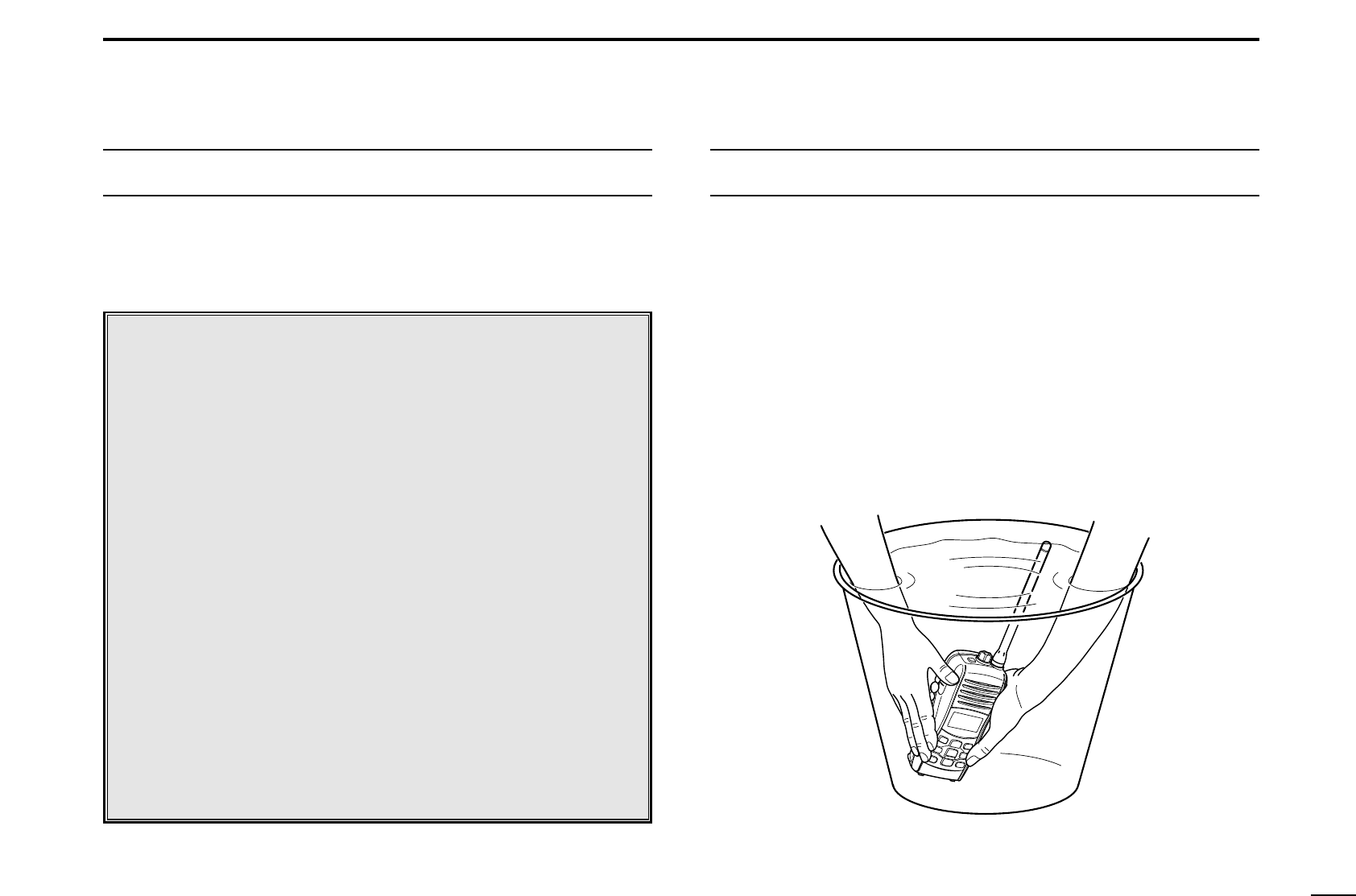
ii
IN CASE OF EMERGENCY
If your vessel requires assistance, contact other vessels and
the Coast Guard by sending a distress call on Channel 16.
❍USING CHANNEL 16
DISTRESS CALL PROCEDURE
1. “MAYDAY MAYDAY MAYDAY.”
2. “THIS IS ...........................” (name of vessel)
3. Your call sign or other indication of the ves-
sel.
4. “LOCATED AT .....................” (your position)
5. The nature of the distress and assistance re-
quired.
6. Any other information which might facilitate
the rescue.
RECOMMENDATION
CLEAN THE TRANSCEIVER THOROUGHLY WITH FRESH
WATER after exposure to saltwater, and dry it before opera-
tion. Otherwise, the transceiver's keys, switches and con-
trollers may become inoperable due to salt crystallization.
NOTE: DO NOT wash the transceiver in water if there is any
reason to suspect the waterproofing may not be effective. For
example, in cases where the battery pack rubber seal is dam-
aged, the transceiver/battery pack is cracked or broken, or
has been dropped, or when the battery pack is detached from
the transceiver.
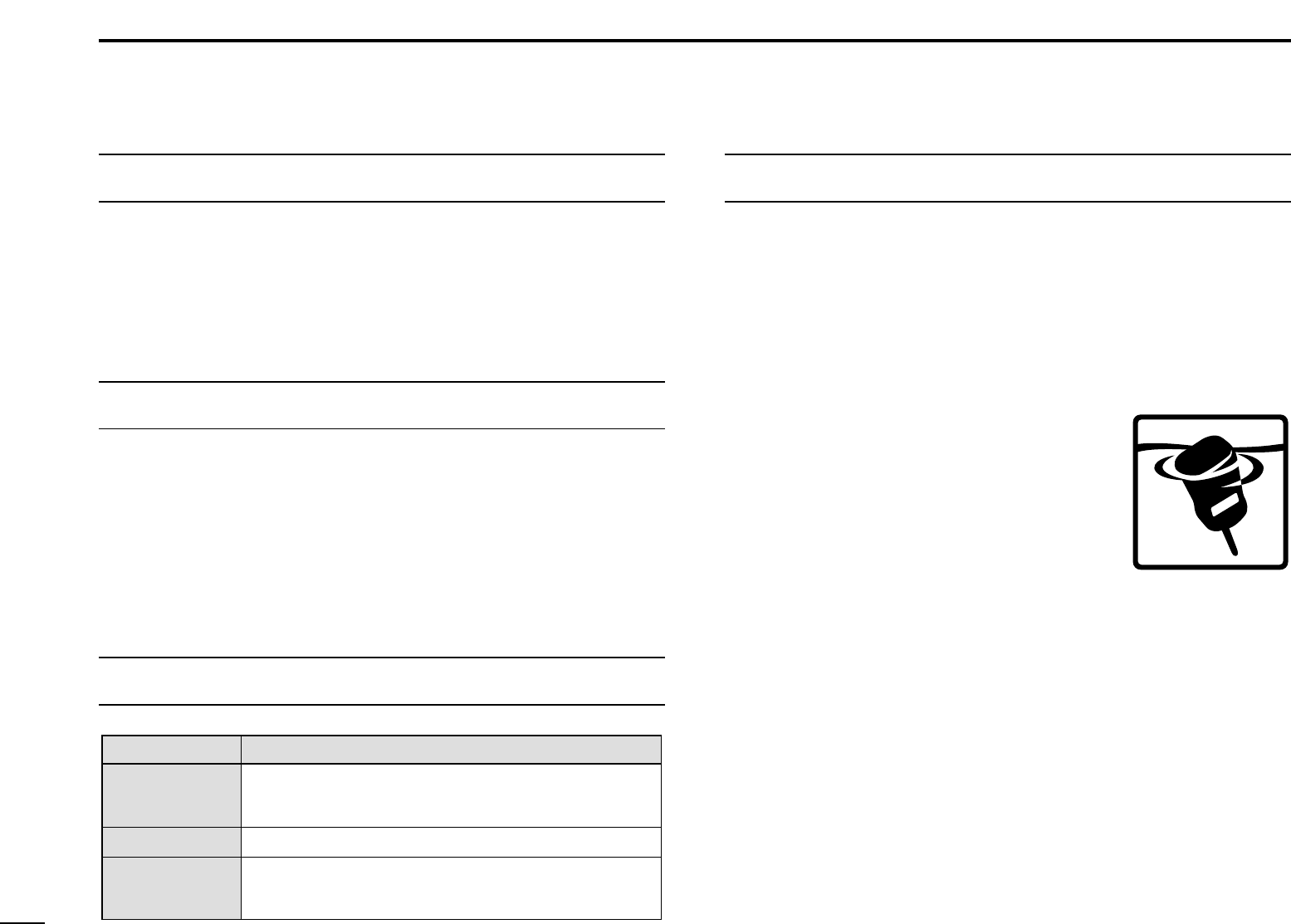
FOREWORD
Thank you for purchasing this Icom product. The IC-M34
VHF
MARINE TRANSCEIVER
is designed and built with Icom’s state of
the art technology and craftsmanship. With proper care this
product should provide you with years of trouble-free operation.
IMPORTANT
READ ALL INSTRUCTIONS carefully and com-
pletely before using the transceiver.
SAVE THIS INSTRUCTION MANUAL—This in-
struction manual contains important operating instructions for
the IC-M34.
EXPLICIT DEFINITIONS
FEATURES
☞Submersible construction
Built tough to withstand the punishing marine environ-
ment, the IC-M34’s submersible construction meets IPX7
of the corresponding International Standard IEC 60529
(2001) while using BP-251 (option) or BP-252.
☞Floating on water
Even when the supplied accessories is
attached, the IC-M34 floats on water.
• When third-party or counterfeit battery
pack, strap, antenna, etc. is used, it may
sink.
☞Large, easy-to-read LCD
With dimensions of 16(H) ×32(W) mm; 5⁄8(H) ×11⁄4(W)
inch, the IC-M34’s function display is easy to read and
shows operating conditions at a glance. Backlighting and
contrast can be adjusted to suit your preferences.
☞Simple operation
9 large buttons on the front panel provide user-friendly op-
eration. The independent volume and channel buttons are
located on the front panel for convenient one-hand opera-
tion.
DEFINITION
RWARNING
CAUTION
NOTE
Personal injury, fire hazard or electric shock
may occur.
If disregarded, inconvenience only. No risk
of personal injury, fire or electric shock.
Equipment damage may occur.
WORD
iii

iv
PRECAUTIONS
RWARNING! NEVER connect the transceiver to an
AC outlet. This may pose a fire hazard or result in an electric
shock.
RWARNING! NEVER hold the transceiver so that the
antenna is closer than 2.5 cm from exposed parts of the body,
especially the face or eyes, while transmitting. The trans-
ceiver will perform best if the microphone is 5 to 10 cm (2 to 4
inches) away from the lips and the transceiver is vertical.
NEVER connect the transceiver to a power source other
than the BP-251 (option) or BP-252. Such a connection will
ruin the transceiver.
AVOID using or placing the transceiver in direct sunlight or
in areas with temperatures below –20°C (–4°F) or above
+60°C (+140°F).
KEEP the transceiver out of the reach of children.
KEEP the transceiver at least 0.9 meters (3.0 ft) away from
your vessel’s magnetic navigation compass.
BE CAREFUL! The transceiver’s right-side panel will
become hot when operating continuously for long periods.
BE CAREFUL! The transceiver employs waterproof
construction, which corresponds to IPX7 of the international
standard IEC 60529 (2001). However, once the transceiver
has been dropped, waterproofing cannot be guaranteed due
to the fact that the transceiver may be cracked, or the water-
proof seal damaged, etc.
MAKE SURE the flexible antenna and battery pack are
securely attached to the transceiver, and that the antenna and
battery pack are dry before attachment. Exposing the inside
of the transceiver to water will result in serious damage to the
transceiver.
For U.S.A. only
CAUTION: Changes or modifications to this device, not
expressly approved by Icom Inc., could void your authority to
operate this device under FCC regulations.
Icom, Icom Inc. and the logo are registered trademarks of Icom Incor-
porated (Japan) in the United States, the United Kingdom, Germany, France,
Spain, Russia and/or other countries.
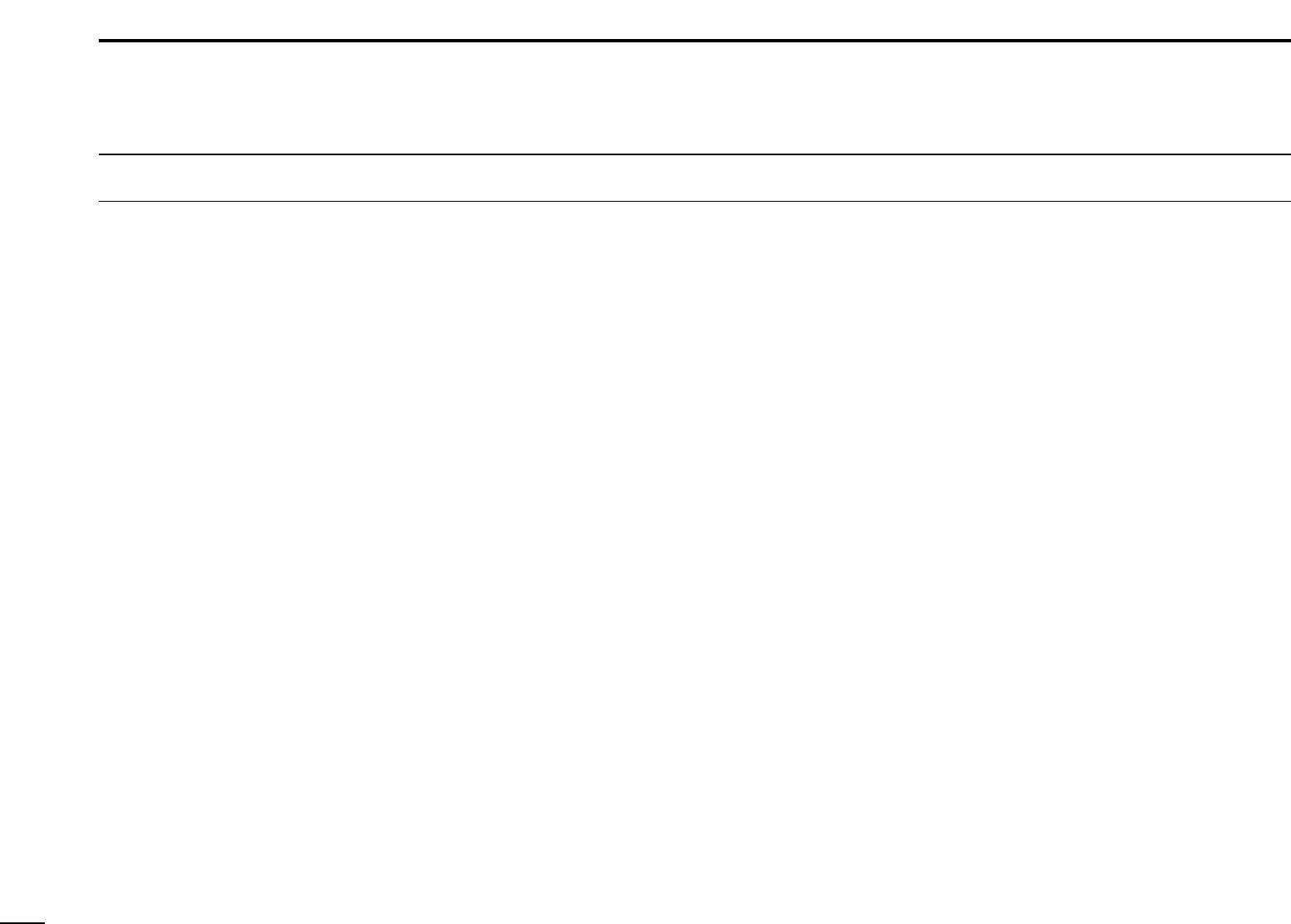
v
SAFETY TRAINING INFORMATION ......................................... i
IN CASE OF EMERGENCY ..................................................... ii
RECOMMENDATION ............................................................... ii
FOREWORD ............................................................................ iii
IMPORTANT ............................................................................ iii
EXPLICIT DEFINITIONS .......................................................... iii
FEATURES .............................................................................. iii
PRECAUTIONS ....................................................................... iv
TABLE OF CONTENTS ............................................................ v
1 OPERATING RULES ......................................................... 1
2 SUPPLIED ACCESSORIES AND ATTACHMENTS ....... 2–3
■Supplied accessories ....................................................... 2
■Attachments ..................................................................... 2
3 PANEL DESCRIPTION .................................................. 4–7
■Front, top and side panels ............................................... 4
■Function display .............................................................. 6
4 BASIC OPERATION .................................................... 8–13
■Channel selection ........................................................... 8
■Receiving and transmitting ............................................ 10
■Call channel programming ............................................ 11
■Adjusting the volume level ............................................. 11
■Volume mute function .................................................... 11
■Adjusting the squelch level ........................................... 12
■Lock function ................................................................. 12
■Automatic backlighting .................................................. 12
■Monitor function ............................................................ 13
■AquaQuake water draining function .............................. 13
5 SCAN OPERATION ................................................... 14–15
■Scan types .................................................................... 14
■Setting TAG channels ................................................... 15
■Starting a scan .............................................................. 15
6 DUALWATCH/TRI-WATCH .............................................. 16
■Description .................................................................... 16
■Operation ...................................................................... 16
7 SET MODE ................................................................. 17–20
■Set mode programming ................................................ 17
■Set mode items ............................................................. 18
8 BATTERY CHARGING ............................................... 21–24
■Battery caution .............................................................. 21
■Supplied battery charger ............................................... 23
■Optional battery case .................................................... 23
■Optional battery charger ............................................... 24
9 OPTIONAL SPEAKER-MICROPHONE ........................... 25
■HM-165 descriptions ..................................................... 25
■Attachment .................................................................... 25
10 TROUBLESHOOTING ..................................................... 26
11 VHF MARINE CHANNEL LIST ........................................ 27
12 SPECIFICATIONS............................................................. 28
13 OPTIONS .......................................................................... 29
TABLE OF CONTENTS
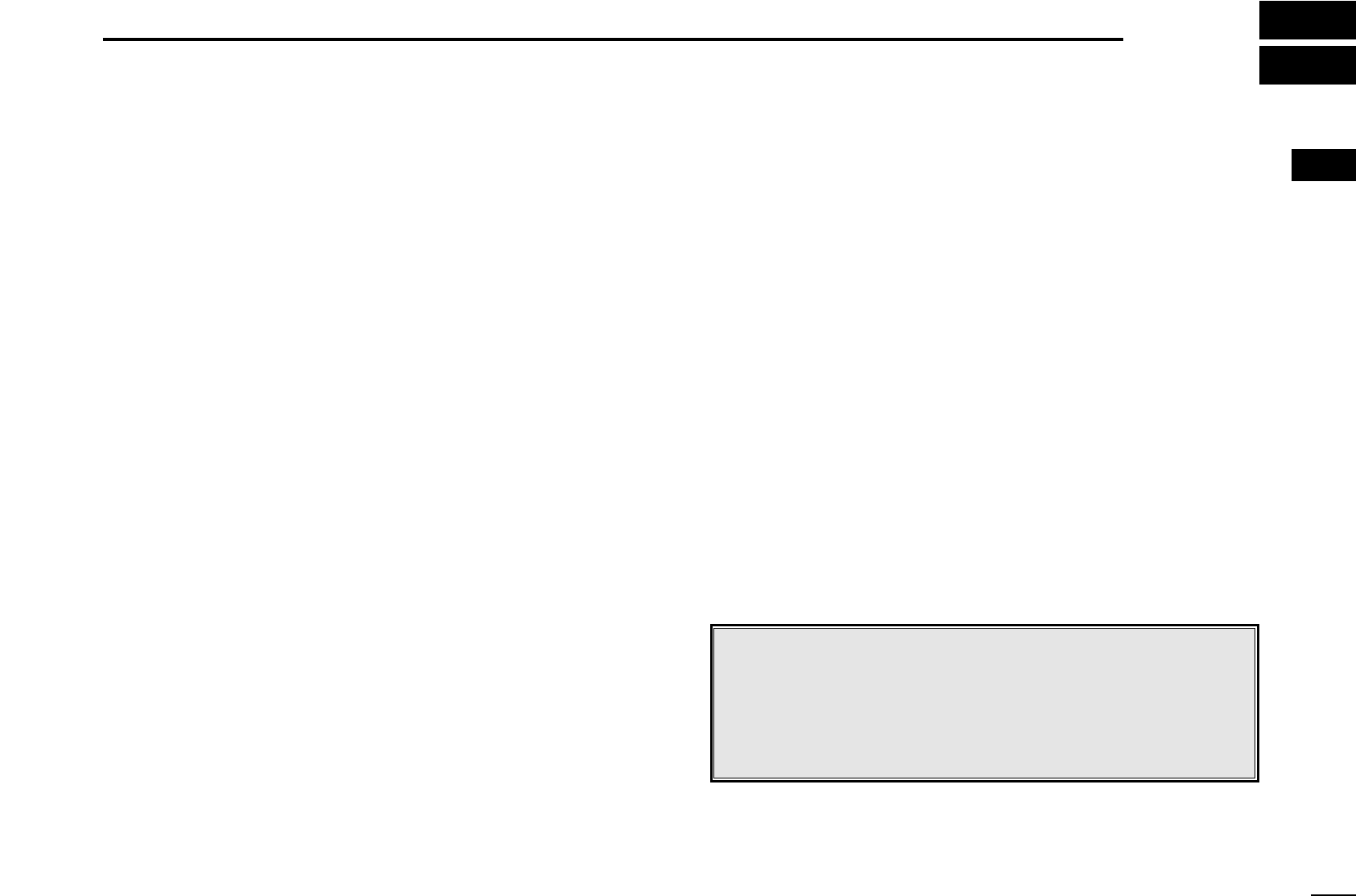
1
1
OPERATING RULES
1
DPriorities
• Read all rules and regulations pertaining to priorities and
keep an up-to-date copy handy. Safety and distress calls
take priority over all others.
• You must monitor Channel 16 when you are not operating
on another channel.
• False or fraudulent distress calls are prohibited under law.
DPrivacy
• Information overheard but not intended for you cannot law-
fully be used in any way.
• Indecent or profane language is prohibited.
DRadio licenses
(1) SHIP STATION LICENSE
When your craft is equipped with a VHF FM transceiver, you
must have a current radio station license before using the
transceiver. It is unlawful to operate a ship station which is not
licensed.
Inquire through your dealer or the appropriate government
agency for a Ship-Radiotelephone license. This license in-
cludes the call sign which is your craft’s identification for radio
purposes.
(2) OPERATOR’S LICENSE
A restricted Radiotelephone Operator Permit is the license
most often held by small vessel radio operators when a radio
is not required for safety purposes.
The Restricted Radiotelephone Operator Permit must be
posted near the transceiver or be kept with the operator. Only
a licensed radio operator may operate a transceiver.
However, non-licensed individuals may talk over a transceiver
if a licensed operator starts, supervises, ends the call and
makes the necessary log entries.
A current copy of the applicable government rules and regu-
lations is only required to be on hand for vessels in which a
radio telephone is compulsory. However, even if you are not
required to have these on hand it is your responsibility to be
thoroughly acquainted with all pertinent rules and regulations.
NOTE: Even though the IC-M34 is capable of operation
on VHF marine channels 3, 21, 23, 61, 64, 81, 82 and 83,
according to FCC regulations these simplex channels can-
not be lawfully used by the general occupational in U.S.A.
waters.
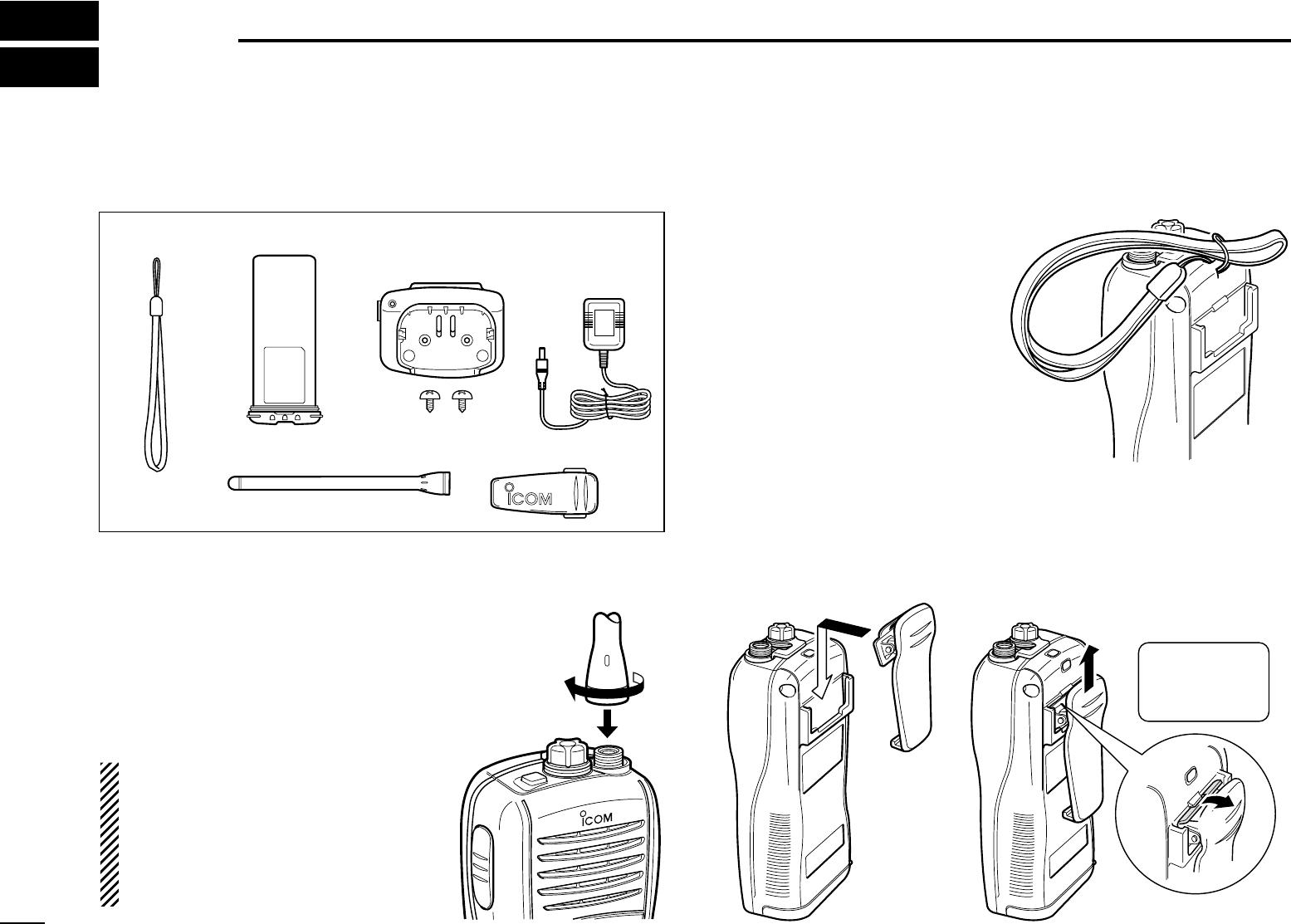
2
SUPPLIED ACCESSORIES AND ATTACHMENTS
2
■Supplied accessories
■Attachments
DFlexible antenna
Connect the supplied flexible an-
tenna to the antenna connector.
CAUTION!
•NEVER HOLD by the antenna
when carrying the transceiver.
• Transmitting without an an-
tenna may damage the trans-
ceiver.
Battery packHandstrap
Belt clip
Battery charger
(with 2 screws)
Antenna
AC adapter
(Depending
on version)
DHandstrap
Pass the handstrap through
the loop on the side of the
transceiver as illustrated at
right. Facilitates carrying.
DBelt clip
Attach/detach the belt clip to the transceiver as illustrated
below.
To attach the belt clip To detach the belt clip
wBe careful!
Not to crack
your nails.
q
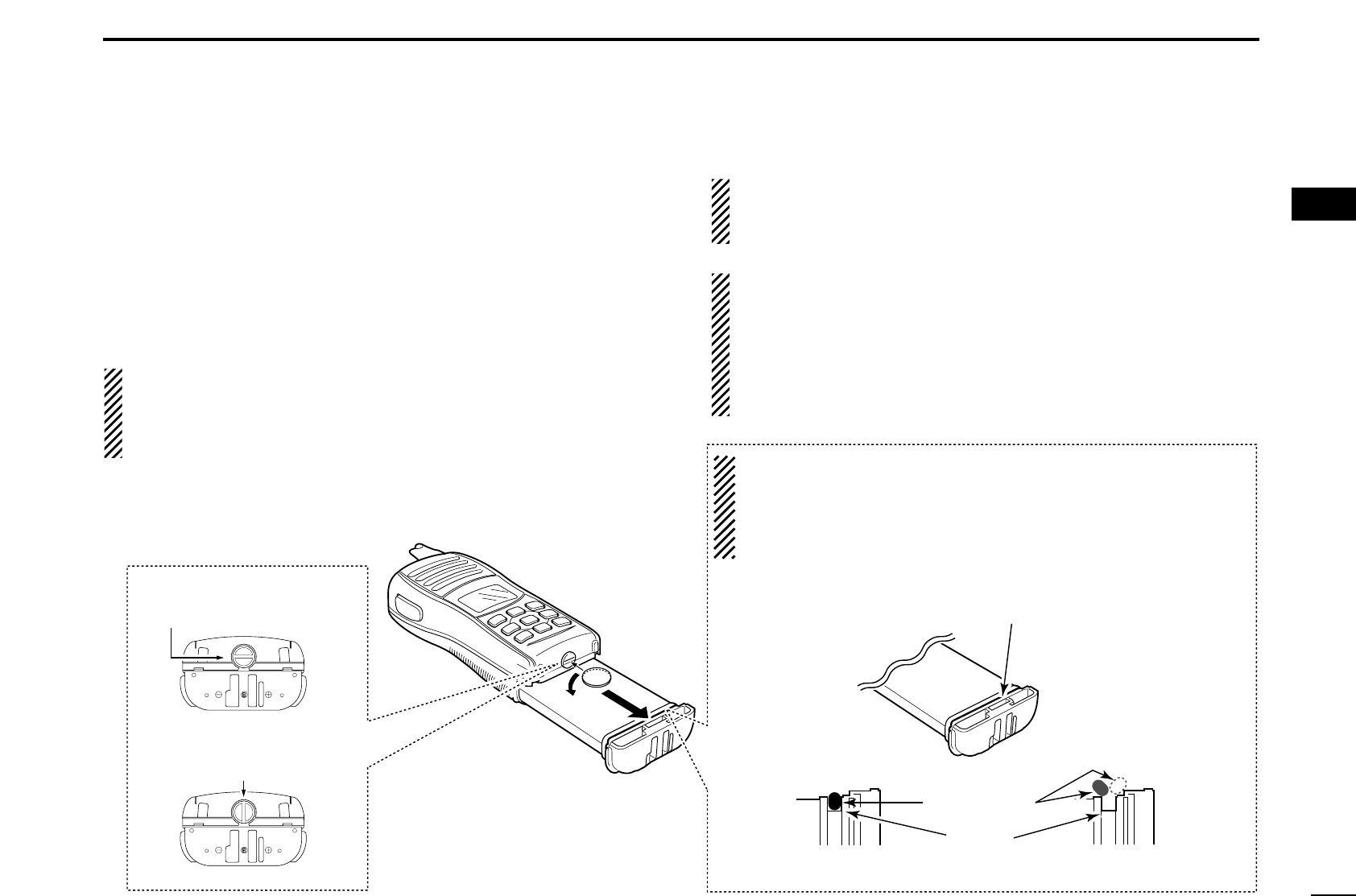
3
2
SUPPLIED ACCESSORIES AND ATTACHMENTS
2
ïBattery pack
To remove the battery pack:
Turn the screw counterclockwise, then pull the battery pack
in the direction of the arrow as shown below.
To attach the battery pack:
Insert the battery pack in the IC-M34 completely, then turn the
screw clockwise.
NEVER remove or insert the battery pack when the trans-
ceiver is wet or soiled. This may result water or dust get-
ting into the transceiver/battery pack and may result in the
transceiver being damaged.
NOTE: When removing or attaching the battery pack, use
a coin or standard screwdriver to loosen or tighten the bot-
tom screw.
CAUTION!:
When attaching or removing a battery pack, make sure the
rubber seal is set in the groove of the battery pack cor-
rectly. If the seal is not neatly in the groove it may be dam-
aged when attaching the battery pack.
If the seal is damaged, waterproofing is not guaranteed.
Screw position
when removing battery
Screw position
when attaching battery
Make sure both the rubber seal (purple) is set to the groove
correctly and dust or else does not adhere to it.
Battery pack Battery pack
Rubber seal
Groove
Correct position Incorrect position
NOTE:
When attaching a battery pack, make sure dust or else does
not adhere to the rubber seal. If dust or else is on the seal
when attaching a battery pack, the water resistant may be
reduced.
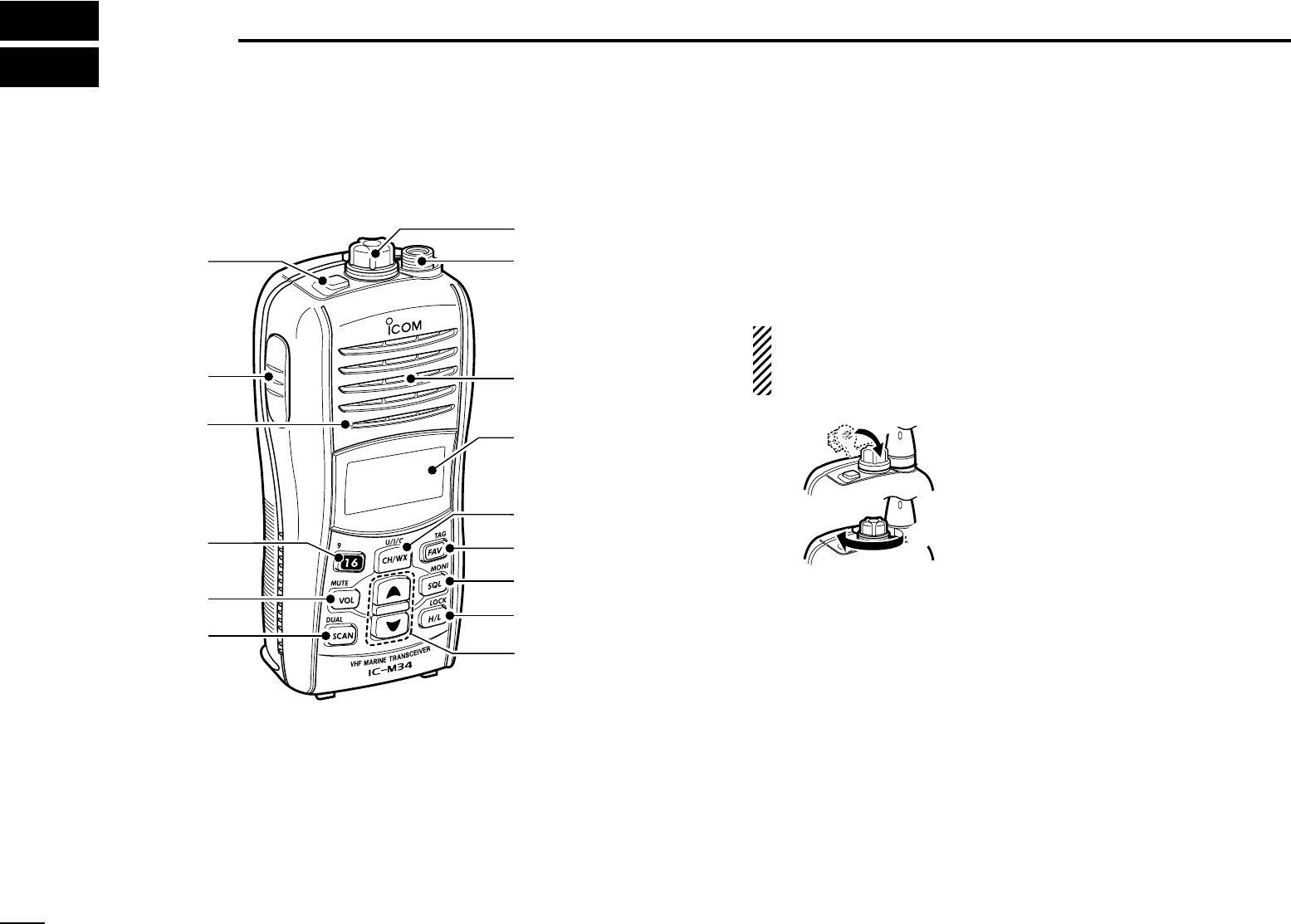
4
PANEL DESCRIPTION
3
■Front, top and side panels
qPOWER SWITCH [PWR]
Push and hold to turn power ON and OFF.
wSPEAKER-MICROPHONE CONNECTOR [SP MIC] (p. 25)
Connects the optional external speaker-microphone.
NOTE: Attach the [SP MIC] cap when the optional
speaker-microphone is not used. Otherwise, water will
get into the transceiver.
eANTENNA CONNECTOR (p. 2)
Connects the supplied antenna.
rCHANNEL/WEATHER CHANNEL KEY [CH/WX•U/I/C]
➥Toggles the regular channels and weather channel when
pushed. (p. 9)
➥Selects the U.S.A., International or Canadian channel
group when pushed and held for 1 sec. (p. 9)
➥Push to return to the condition before selecting the
channel 16 or the call channel.
q Attach the
[SP MIC]
cap.
w Then rotate it clockwise
completely.
w
q
Microphone Function display
(pgs. 6, 7)
Speaker
o
!2
!1
!0
i
t
y
u
r
w
qe

5
3
PANEL DESCRIPTION
3
tFAVORITE/TAG KEY [FAV•TAG]
➥While pushing and holding this key, push [Y]/[Z] to se-
lect the favorite (TAG) channels in the selected channel
group in sequence. (p. 8)
• Pushing this key only selects the favorite (TAG) channels up-
ward.
➥Push and hold for 1 sec. to set or clear the displayed
channel as a TAG (scanned) channel. (p. 15)
➥While pushing and holding this key, turn power ON to
clear or set all TAG channels (when no TAG channel
setting) in the selected channel group. (p. 15)
ySQUELCH/MONITOR KEY [SQL•MONI]
➥Push this key, then adjust the squelch level with [Y]/[Z].
(p. 12)
➥Manually opens the squelch for monitoring the channel
while pushing and holding. (p. 13)
➥While pushing and holding this key, turn power ON to
enter the set mode. (p. 17)
uTRANSMIT POWER/LOCK KEY [H/L•LOCK]
➥Selects high or low power when pushed. (p. 10)
➥Toggles the key lock function ON/OFF when pushed and
held for 1 sec. (p. 12)
iCHANNEL UP/DOWN KEYS [Y]/[Z]
➥Selects an operating channel. (pgs. 8, 9)
➥Selects the set mode condition of the item. (p. 17)
➥Checks TAG channels or changes scanning direction
during scan. (p. 15)
oSCAN/DUAL KEY [SCAN•DUAL]
➥Push to start and stops normal or priority scan. (p. 15)
➥Push and hold for 1 sec. to enter watch mode. (p. 16)
➥Exits watch mode when pushed during watch operation.
(p. 16)
!0 VOLUME KEY [VOL•MUTE]
➥Push this key, then adjust the volume level with [Y]/[Z].
(p. 11)
➥Push and hold for 1 sec. to activate the volume mute
function. (p. 11)
!1 CHANNEL 16 KEY [16•9]
➥Push to select Channel 16. (p. 8)
➥Push and hold for 1 sec. to select the call channel. (p. 8)
➥Enters call channel programming condition when the call
channel is selected and this key is pushed and held for 3
sec. (p. 11)
➥Push to exit set mode during set mode operation. (p. 17)
!2 PTT SWITCH [PTT]
Push and hold to transmit; release to receive. (p. 10)
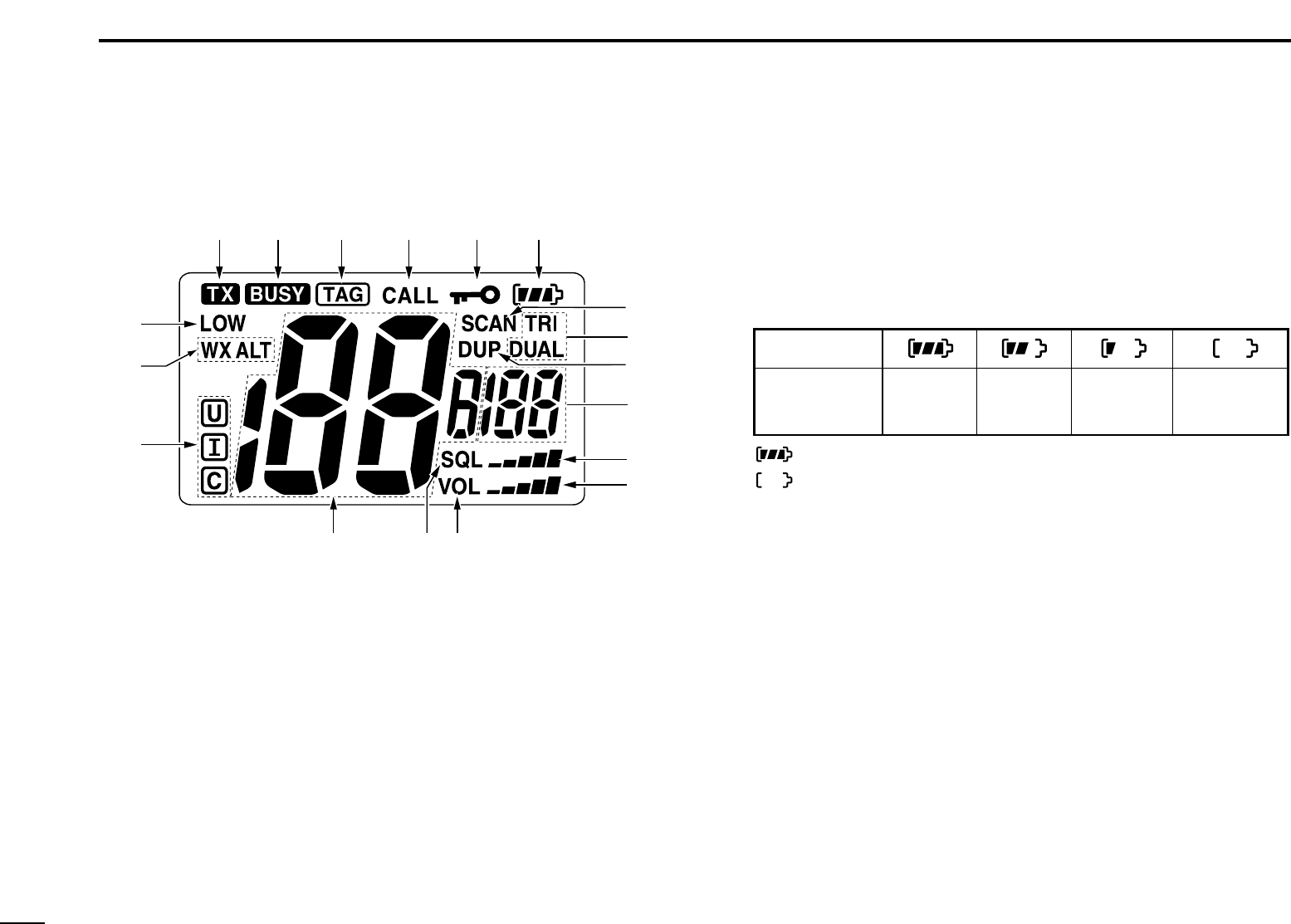
6
3PANEL DESCRIPTION
■Function display
qTRANSMIT INDICATOR (p. 10)
Appears while transmitting.
wBUSY INDICATOR
➥Appears when receiving a signal or when the squelch
opens. (p. 10)
➥Blinks while monitoring. (p. 13)
eTAG CHANNEL INDICATOR (p. 15)
Appears when a TAG channel is selected.
rCALL CHANNEL INDICATOR (p. 8)
Appears when the call channel is selected.
tLOCK INDICATOR (p. 12)
Appears while the lock function is activated.
yBATTERY INDICATOR
Indicates remaining battery power.
uSCAN INDICATOR (p. 15)
Blinks while scanning.
iDUALWATCH/TRI-WATCH INDICATORS (p. 16)
“DUAL” appears during dualwatch; “TRI” appears during
tri-watch.
oDUPLEX INDICATOR
Appears when a duplex channel is selected.
!0 SUB CHANNEL READOUT
➥Indicates Channel 16 during priority scan, dualwatch or
tri-watch. (p. 16)
➥Indicates the set mode item while in set mode. (p. 17)
➥Indicates the squelch level while squelch setting. (p. 12)
➥Indicates the volume level while volume setting. (p. 11)
Indication
Full Middle Charging
required No battery
Battery level
blinks when the battery is exhaustion.
blinks when the battery over charged.
!5 !3!4
i
u
o
!2
!1
!0
!8
!6
qer ytw
!7

7
3
PANEL DESCRIPTION
3
!1 SQUELCH LEVEL INDICATOR
Shows the squelch level.
!2 VOLUME LEVEL INDICATOR
➥Shows the volume level.
➥Blinks when the volume mute is activated. (p. 11)
!3 VOLUME LEVEL ADJUSTING INDICATOR (p. 11)
Blinks while adjusting the volume level.
!4 SQUELCH LEVEL ADJUSTING INDICATOR (p. 12)
Blinks while adjusting the squelch level.
!5 CHANNEL NUMBER READOUT
➥Indicates the selected operating channel number.
➥In set mode, indicates the selected condition.
!6 CHANNEL GROUP INDICATOR (p. 9)
“U” appears when U.S.A.; “ ” appears when Interna-
tional; “C” appears when Canadian channel group is se-
lected.
!7 WEATHER CHANNEL/WEATHER ALERT INDICATORS
(p. 9)
➥“WX” appears when the weather channel group is se-
lected.
➥“WX ALT” appears while the weather alert function is ac-
tivated; blinks when the alert tone is received.
!8 LOW POWER INDICATOR (p. 10)
➥“LOW” appears when low power is selected.
➥“LOW” blinks when switching forced low power mode
because of a high temperature error or low voltage.
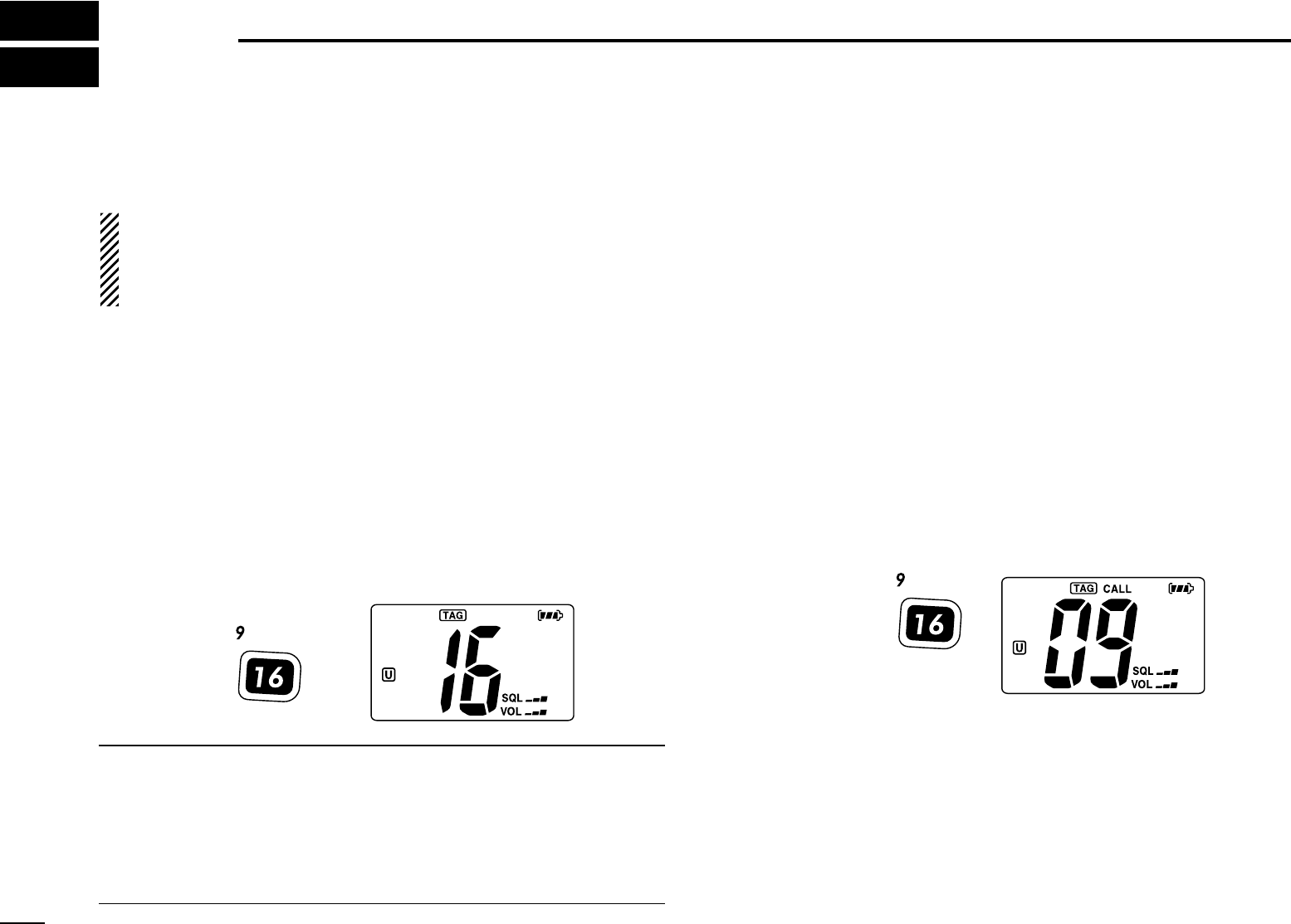
8
BASIC OPERATION
4
■Channel selection
IMPORTANT!: Prior to using the transceiver for the first
time, the battery pack must be fully charged for optimum
life and operation. To avoid damage to the transceiver, turn
the power OFF while charging.
DChannel 16
Channel 16 is the distress and safety channel. It used for es-
tablishing initial contact with a station and for emergency
communications. Channel 16 is monitored during both Dual-
watch and Tri-watch. While standing by, you must monitor
Channel 16.
qPush [16] momentarily to select Channel 16.
wPush [CH/WX] to return to the condition before selecting
Channel 16, or push [Y]/[Z]to select a channel.
Convenient!
While pushing and holding [FAV], push [Y]/[Z] to select the
favorite (TAG) channels in the selected channel group in se-
quence.
• Pushing [FAV] only selects the favorite (TAG) channels upward.
• The favorite channels are set by the TAG channel setting. (p. 15)
DChannel 9 (Call channel)
Each regular channel group has separate leisure-use call
channels. The call channel is monitored during Tri-watch. The
call channels can be programmed (p. 11) and are used to
store your most often used channel in each channel group for
quick recall.
qPush and hold [9] (16) for 1 sec. to select the call channel
of the selected channel group.
•“CALL” and call channel number appear.
• Each channel group may have an independent call channel after
programming a call channel. (p. 11)
wPush [CH/WX] to return to the condition before selecting
call channel, or push [Y]/[Z]to select a channel.
Push and hold
for 1 sec.
Push
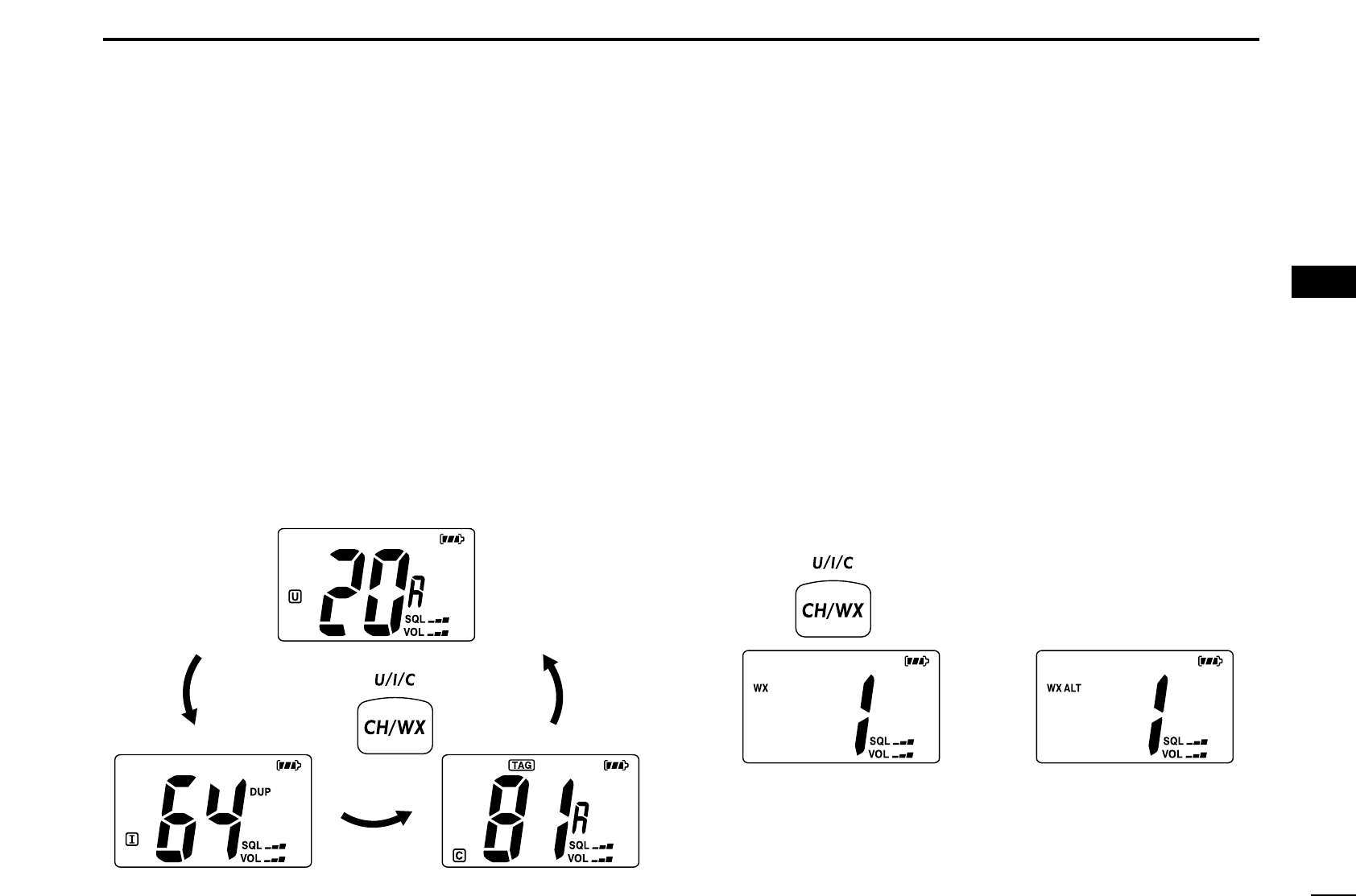
9
4
BASIC OPERATION
4
DU.S.A., International and Canadian channels
The IC-M34 is pre-programmed with 59 U.S.A., 59 Interna-
tional and 63 Canadian channels. These channel groups may
be specified for the operating area.
qPush [CH/WX] to select a regular channel.
• If a weather channel appears, push [CH/WX] again.
wPush and hold [U/I/C] (CH/WX) for 1 sec. several times to
change the channel group.
• U.S.A., International and Canadian channel groups can be se-
lected in sequence.
ePush [Y]/[Z]to select a channel.
•“DUP” appears for duplex channels.
DWeather channels
The IC-M34 has 10 pre-programmed weather channels.
These are used for monitoring broadcasts from the NOAA
(National Oceanographic and Atmospheric Administration).
The transceiver can automatically detect a weather alert tone
on the selected weather channel while receiving the channel
or while scanning. (p. 18)
qPush [CH/WX] once or twice to select a weather channel.
•“WX” appears when a weather channel is selected.
•“WX ALT” appears when the weather alert function is turned ON.
(p. 18)
wPush [Y]/[Z]to select a weather channel.
Push once or twice.
Weather alert is OFF. Weather alert is ON.
Push and hold
U.S.A. channels
International channels Canadian channels
for 1 sec.
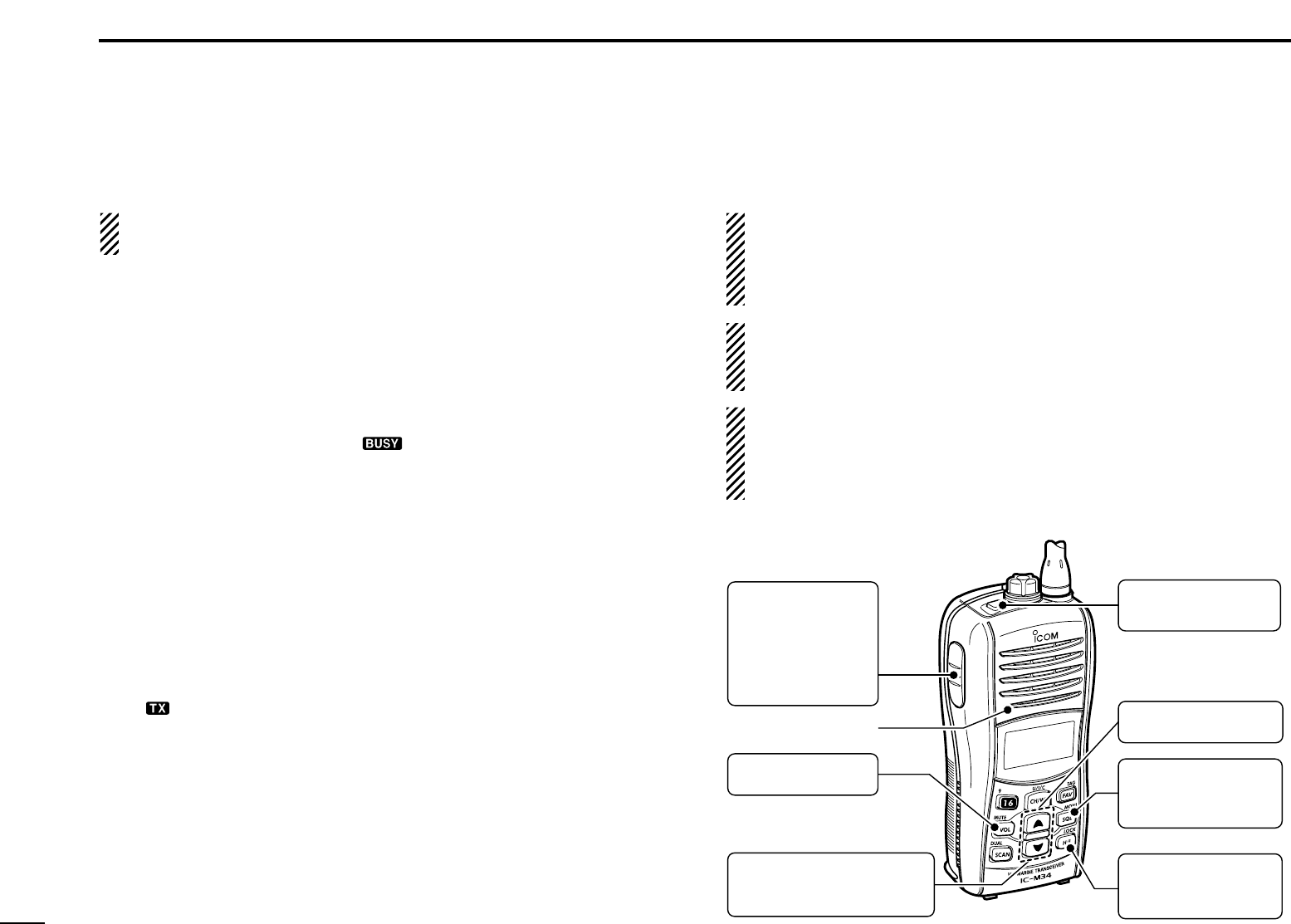
10
4BASIC OPERATION
■Receiving and transmitting
CAUTION: Transmitting without an antenna will damage
the transceiver.
qPush and hold [PWR] to turn power ON.
wSet the audio and squelch levels.
➥Push [SQL], and push [Z]several times to open the squelch.
➥Push [VOL], then push [Y]/[Z]to adjust the volume level.
➥Push [SQL], and push [Y]until the noise disappears.
ePush [Y]/[Z]to select the desired channel.
• When receiving a signal, “ ” appears and audio is emitted
from the speaker.
• Further adjustment of the audio may be necessary at this point.
rPush [H/L] to select the output power if necessary.
•“LOW” appears when low power is selected; no indication when
high power is selected.
• Choose low power to conserve battery power, choose high
power for longer distance communications.
• Some channels are for low power only.
tPush and hold [PTT] to transmit, then speak into the
microphone.
• “ ” appears.
• Channel 70 cannot be used for transmission.
yRelease [PTT] to receive.
IMPORTANT: To maximize the readability of your trans-
mitted signal, pause a few sec. after pushing [PTT], hold
the microphone 2 to 4 inches (5 to 10 cm) from your mouth
and speak into the microphone at a normal voice level.
NOTE: The transceiver has a power save function to con-
serve the battery power. The power save function activates
automatically when no signal is received for 5 sec.
For U.S.A version:To prevent accidental prolonged trans-
mission, etc., the IC-M34 has a time-out timer function.
This timer cuts a transmission OFF after 5 min. of continu-
ous transmission.
Microphone
r Set output
power
q Power ON
w Set the
squelch level
w Set volume
t Push to
transmit
y Release to
receive
eSet channel
Set the squelch
and volume level.
w
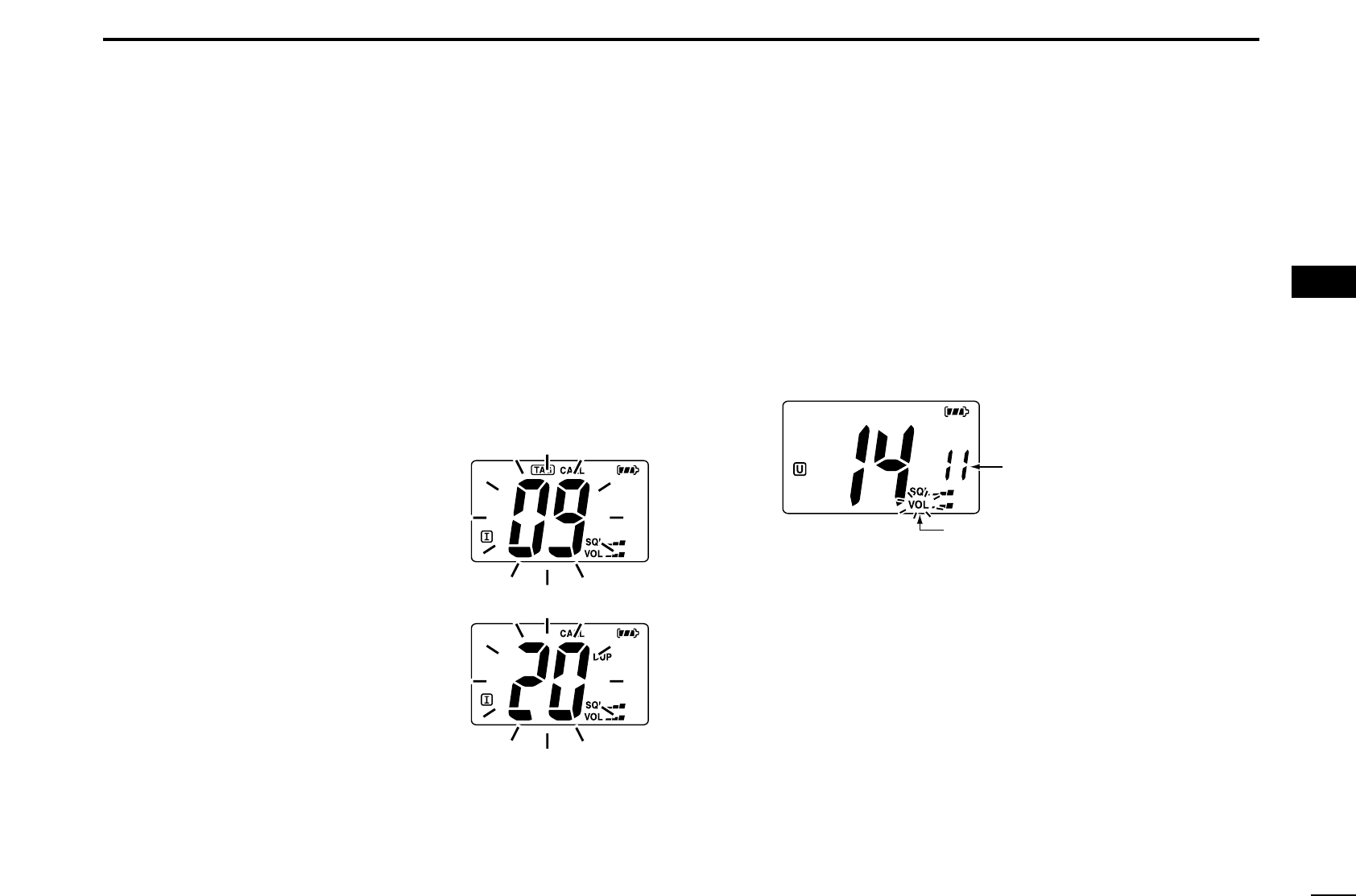
11
4
BASIC OPERATION
4
■Call channel programming
Call channel is used to select Channel 9 (default), however,
you can program the call channel with your most often-used
channels in each channel group for quick recall.
qPush and hold [U/I/C] (CH/WX) for 1 sec. several times to
select the desired channel group (U.S.A., International or
Canada) to be programmed.
wPush and hold [9] (16) for 1 sec. to select the call channel
of the selected channel group.
•“CALL” and call channel number appear.
ePush and hold [9] (16) again for 3
sec. (until a long beep changes to
2 short beeps) to enter call chan-
nel programming condition.
• Channel number starts blinking.
rPush [Y]/[Z]to select the desired
channel.
tPush [16] to program the dis-
played channel as the call chan-
nel.
• The channel number stops blinking.
■Adjusting the volume level
The volume level can be adjusted with [VOL] and [Y]/[Z].
qPush [VOL], then adjust the volume level with [Y]/[Z].
•“VOL” indicator starts blinking.
• There are 31 volume levels and OFF.
• When no key is pushed for 5 sec., the transceiver returns to nor-
mal condition.
wPush [VOL] again to return to normal condition.
■Volume mute function
The volume mute function can be activated temporarily with
[MUTE] (VOL).
qPush and hold [MUTE] (VOL) for 1 sec to activate the vol-
ume mute function.
• The audio is muted.
• The volume level indicator starts blinking.
wPush [VOL] again or turn power OFF to turn the volume
mute function OFF.
Indicates the
volume level.
Blinks during volume level adjustment.
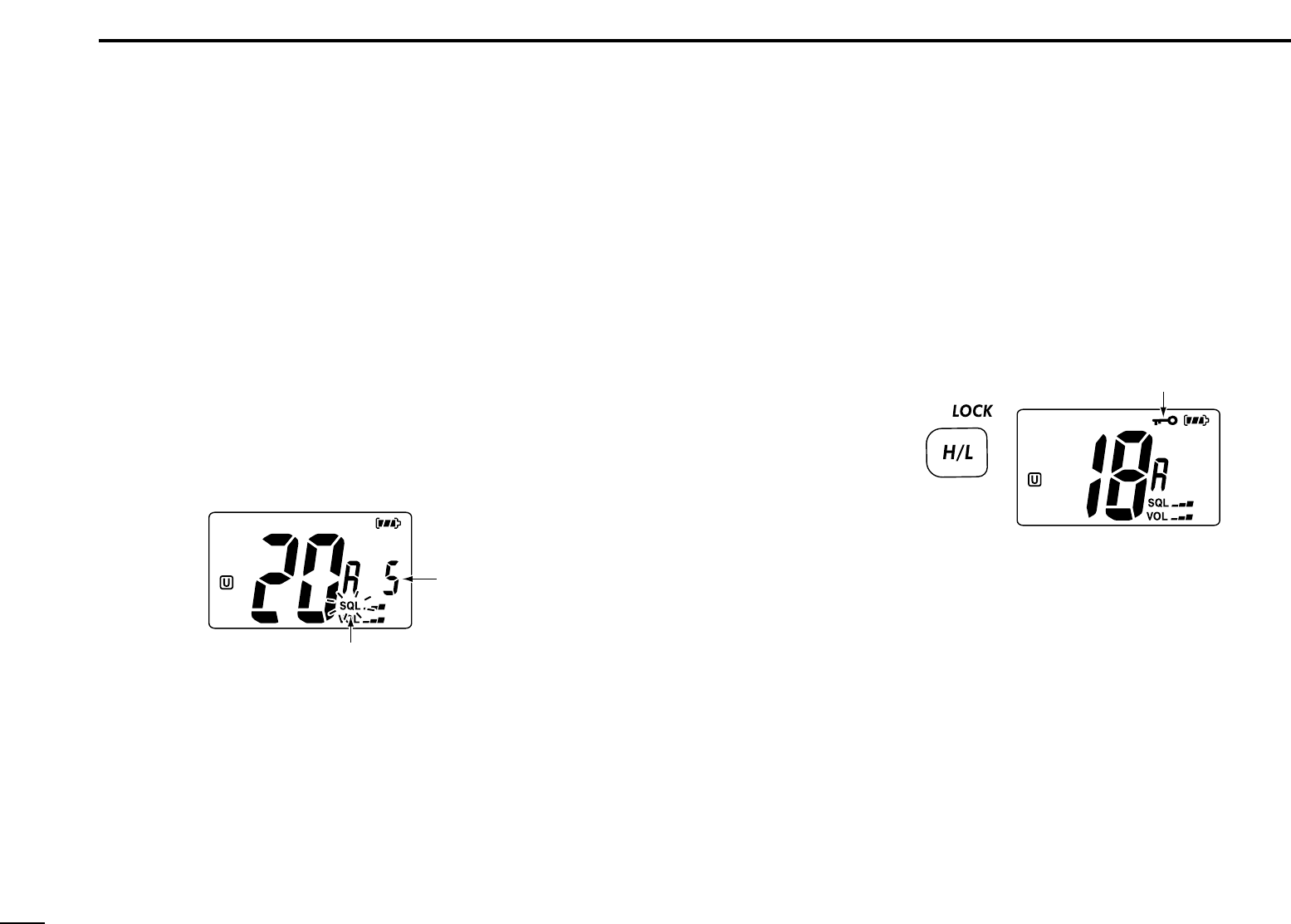
12
4BASIC OPERATION
■Adjusting the squelch level
To adjust the IC-M34’s squelch level, use the [Y]/[Z]keys as
desired below. In order to receive signals properly, as well as
for the scan to function effectively, the squelch must be ad-
justed to the proper level.
qPush [SQL], then adjust the squelch level with [Y]/[Z].
•“SQL” indicator starts blinking.
• There are 11 squelch levels to choose from: OP is completely
open; 10 is tight squelch; 1 is loose squelch level.
• When no key is pushed for 5 sec., the transceiver returns to nor-
mal condition.
wPush [SQL] again to return to normal condition.
■Lock function
This function electronically locks all keys (except for [PTT],
[SQL•MONI],[VOL•MUTE],[H/L•LOCK] and [Y]/[Z]*) to
prevent accidental channel changes and function access.
➥Push and hold [LOCK] (H/L) for 1 sec. to turn the lock
function ON and OFF.
* Activates after pushing [VOL] or [SQL] only.
■Automatic backlighting
This function is convenient for nighttime operation. The auto-
matic backlighting can be activated in set mode. (p. 19)
➥Push any key except for [PTT] to turn the backlighting ON.
• The backlighting is automatically turned OFF after 5 sec. of in-
activity.
Push and hold
for 1 sec.
Appears while the lock
function is used.
Blinks during squelch
level adjustment.
Indicates the
squelch level.
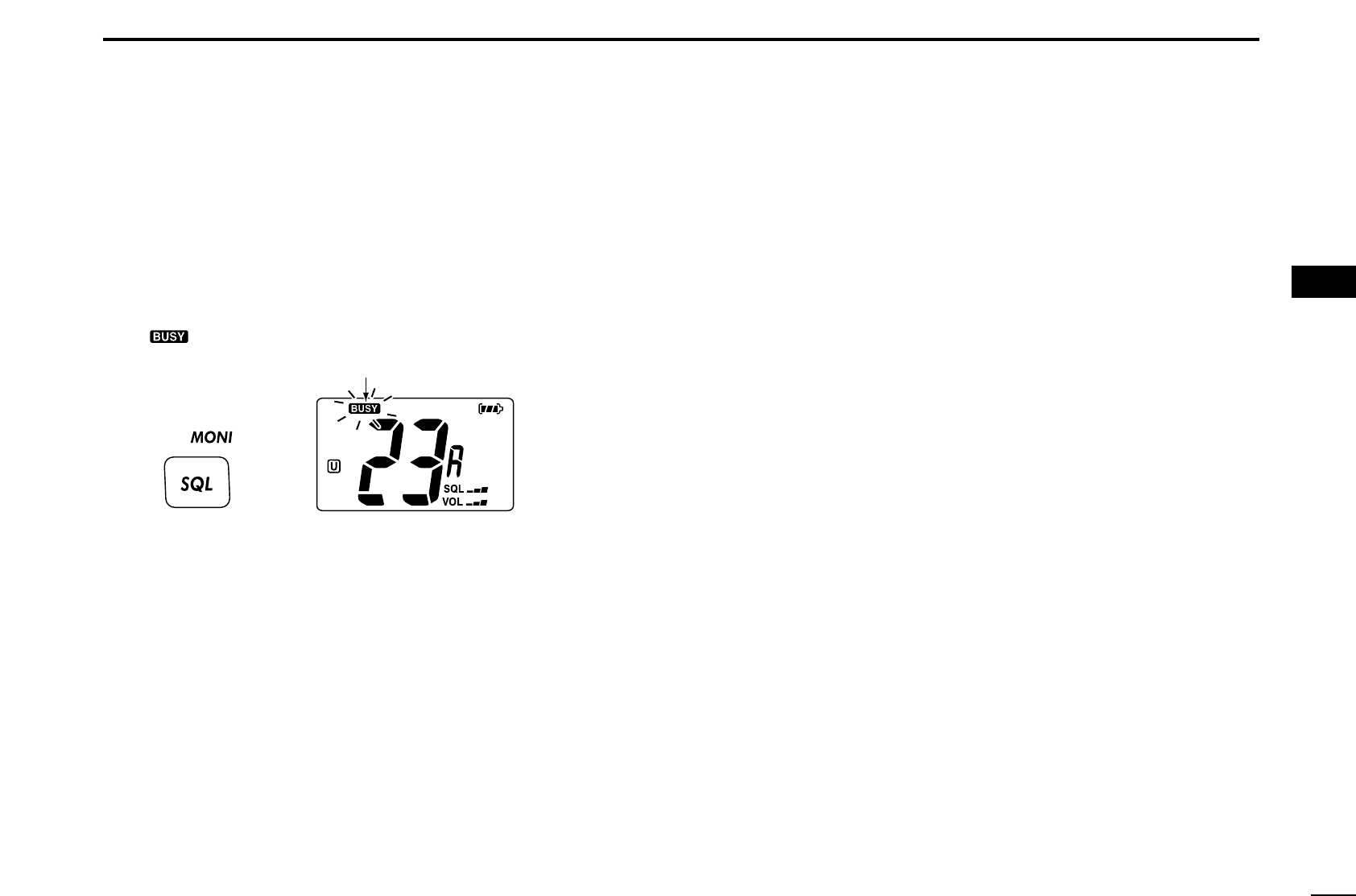
13
4
BASIC OPERATION
4
■Monitor function
The monitor function releases the noise squelch mute. See
p. 5 for details of the monitor key action.
➥The monitor function activates while pushing and holding
[MONI] (SQL).
• “ ” blinks and audio is emitted.
■
AquaQuake water draining function
The IC-M34 uses a new technology to clear water away from
the speaker grill: AquaQuake. AquaQuake helps drain water
away from the speaker housing (water that might otherwise
muffle the sound coming from the speaker). The IC-M34
emits a vibrating beep when this function is being used.
➥Push and hold both [SCAN] and [H/L].
• A low beep tone sounds for 9 sec. to drain water, regardless of
volume level setting.
• The transceiver never accepts a key operation while the
AquaQuake function is activated. And this function won’t be acti-
vated when an optional speaker-microphone is connected.
Push and hold
Blinks while the monitor function is used.
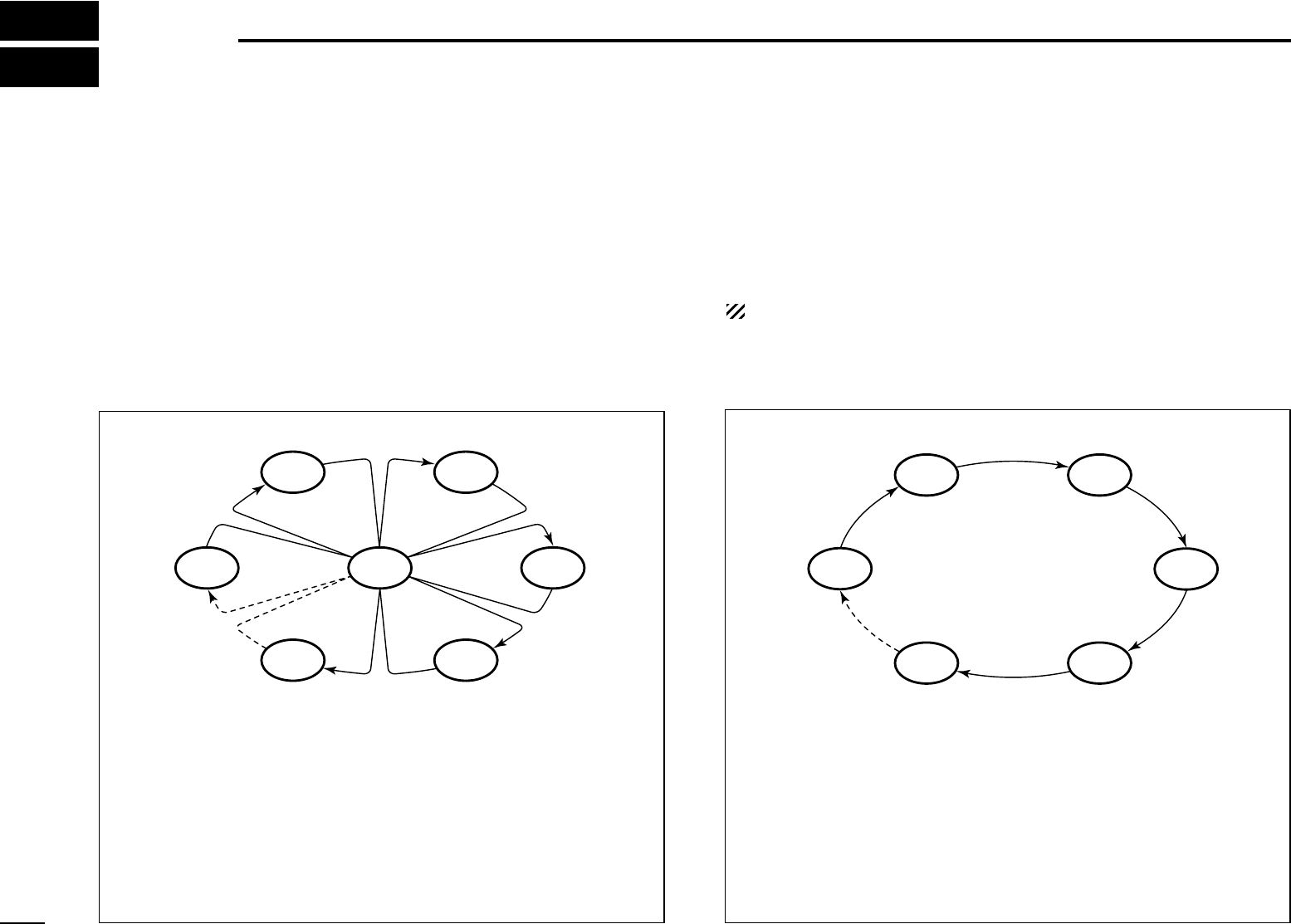
14
SCAN OPERATION
5
■Scan types
Scanning is an efficient way to locate signals quickly over a
wide frequency range. The transceiver has priority scan and
normal scan.
In addition, the weather alert and auto scan function is avail-
able for standby convenience. These functions can be acti-
vated simultaneously, depending on the settings in set mode.
(pgs. 18, 19)
Set the TAG channels (scanned channel) before scanning.
Clear the TAG channels which inconveniently stop scanning,
such as digital communications.
Choose priority or normal scan in set mode. (p. 18)
PRIORITY SCAN
Priority scan searches through all TAG channels in se-
quence while monitoring Channel 16. When a signal is de-
tected on Channel 16, scan pauses until the signal disap-
pears; when a signal is detected on a channel other than
Channel 16, scan becomes dualwatch until the signal dis-
appears.
WX*
CH 01
CH 16
CH 02
CH 05 CH 04
CH 03
Previously selected weather channel
when weather alert function is ON.
*
NORMAL SCAN
Normal scan, like priority scan, searches through all TAG
channels in sequence. However, unlike priority scan, Chan-
nel 16 is not checked unless Channel 16 is set as a TAG
channel.
CH 01 CH 02
WX*
CH 05 CH 04
CH 03
Previously selected weather channel
when weather alert function is ON.
*
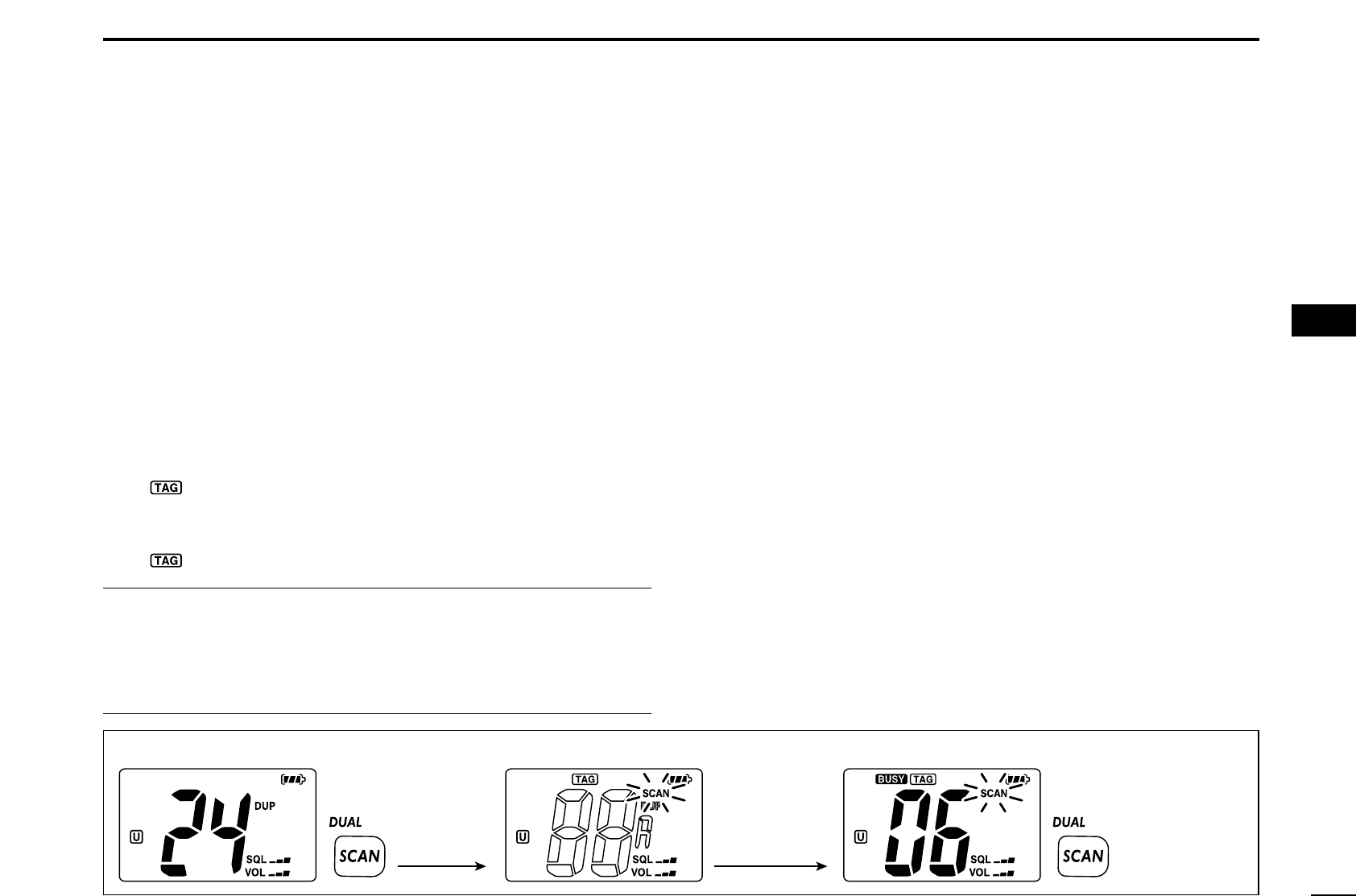
15
5
SCAN OPERATION
■Setting TAG channels
For more efficient scanning, add the desired channels as TAG
channels or clear the TAG for unwanted channels.
Channels that are not tagged will be skipped during scanning.
TAG channels can be assigned to each channel group
(U.S.A., International and Canada) independently.
qPush and hold [U/I/C] (CH/WX) for 1 sec. several times to
select the desired channel group, if desired.
wSelect the desired channel to be set as a TAG channel.
ePush and hold [TAG] (FAV) for 1 sec. to set the displayed
channel as a TAG channel.
• “ ” appears in the function display.
rTo cancel the TAG channel setting, push and hold [TAG]
(FAV) for 1 sec.
• “ ” disappears.
✔Clearing (or setting) all tagged channels
While pushing and holding [TAG] (FAV), turn power ON to
clear all TAG channels in the selected channel group.
• Repeat above procedure to set all channels as TAG channels
(when no TAG channel setting).
■Starting a scan
Set the weather alert function, priority scan function, scan re-
sume timer and auto scan function in advance, using set
mode. (pgs. 18, 19)
qPush and hold [U/I/C] (CH/WX) for 1 sec. several times to
select the desired channel group, if desired.
• When the weather alert function is in use, select the desired
weather channel with [CH/WX] and [Y]/[Z].
wPush [SCAN] to start priority or normal scan.
•“SCAN” blinks in the function display.
• “16” appears on the sub channel readout during priority scan.
• When a signal is received, scan pauses until the signal disap-
pears or resumes after pausing 5 sec. according to scan resume
timer setting. (Channel 16 is still monitored during priority scan.)
• Push [Y]/[Z] to check the scanning TAG channels, change the
scanning direction or resume the scan manually.
eTo stop the scan, push [SCAN].
•“SCAN” disappears.
• Pushing [PTT],[16],[CH/WX] or [FAV] also stops the scan.
[Example]: Starting a normal scan.
5
Scan starts
to stop the scan
PushPush
When a signal
is received
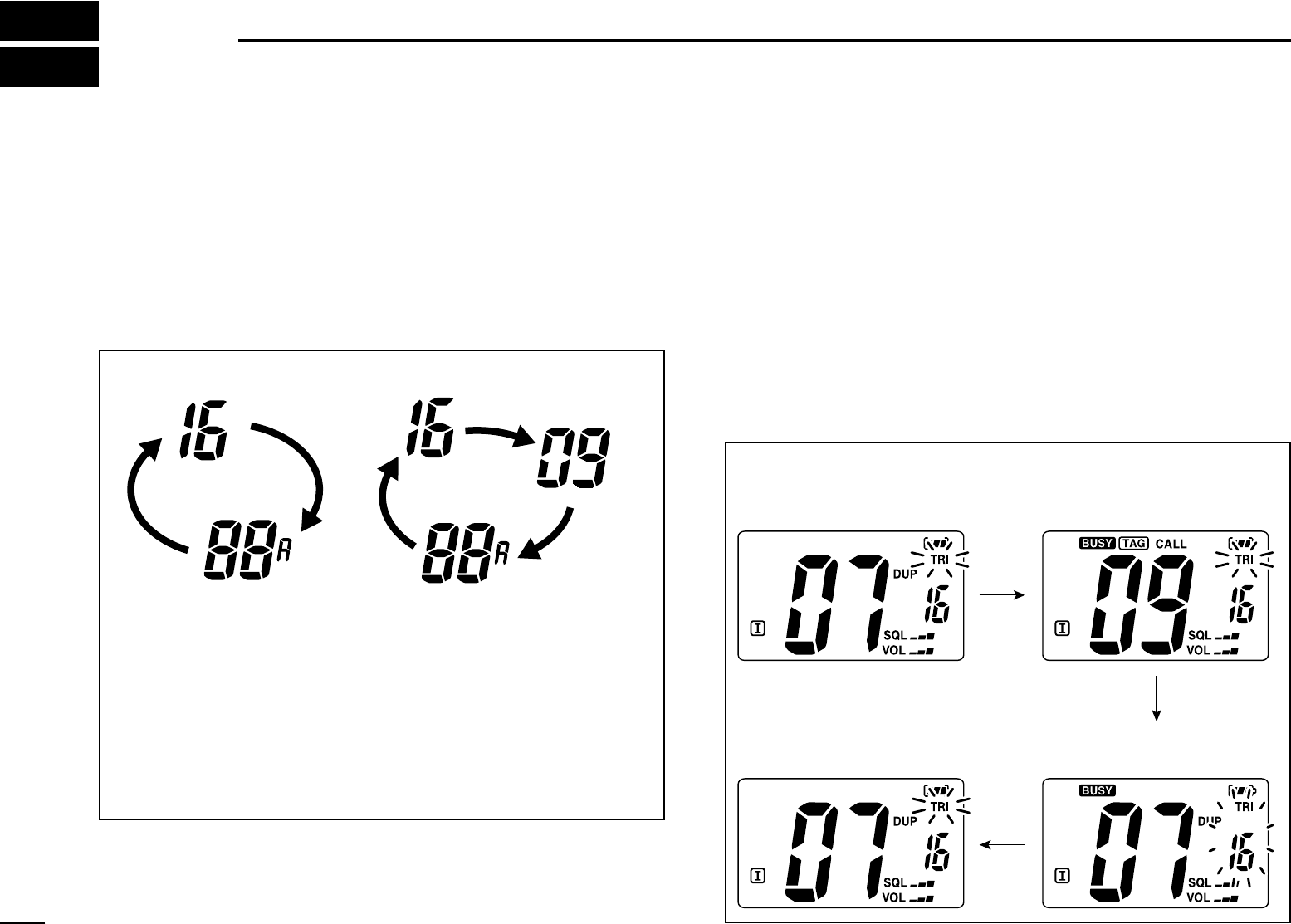
16
DUALWATCH/TRI-WATCH
6
■Description
Dualwatch monitors Channel 16 while you are receiving
on another channel; Tri-watch monitors Channel 16 and the
call channel while receiving another channel. Dualwatch/Tri-
watch is convenient for monitoring Channel 16 when you are
opening on another channel.
■Operation
qSelect Dualwatch or Tri-watch in set mode. (p. 19)
wSelect the desired channel.
ePush and hold [DUAL] (SCAN) for 1 sec. to start Dual-
watch or Tri-watch (depending on set mode setting).
•“DUAL” blinks during dualwatch; “TRI” blinks during tri-watch.
• A beep tone sounds when a signal is received on Channel 16.
• Tri-watch becomes dualwatch when receiving a signal on the call
channel.
rTo cancel dualwatch/tri-watch, push [SCAN] again.
DUALWATCH/TRI-WATCH SIMULATION
• If a signal is received on Channel 16, dualwatch/tri-watch
pauses on Channel 16 until the signal disappears.
• If a signal is received on the call channel during Tri-watch,
Tri-watch becomes Dualwatch until the signal disappears.
• To transmit on the selected channel during Dualwatch/Tri-
watch, push and hold [PTT].
Dualwatch Tri-watch
Call channel
[Example]: Operating Tri-watch on INT channel 07.
Tri-watch starts. Signal is received on call
channel.
Signal received on Channel
16 takes priority.
Tri-watch resumes after
the signal disappears.
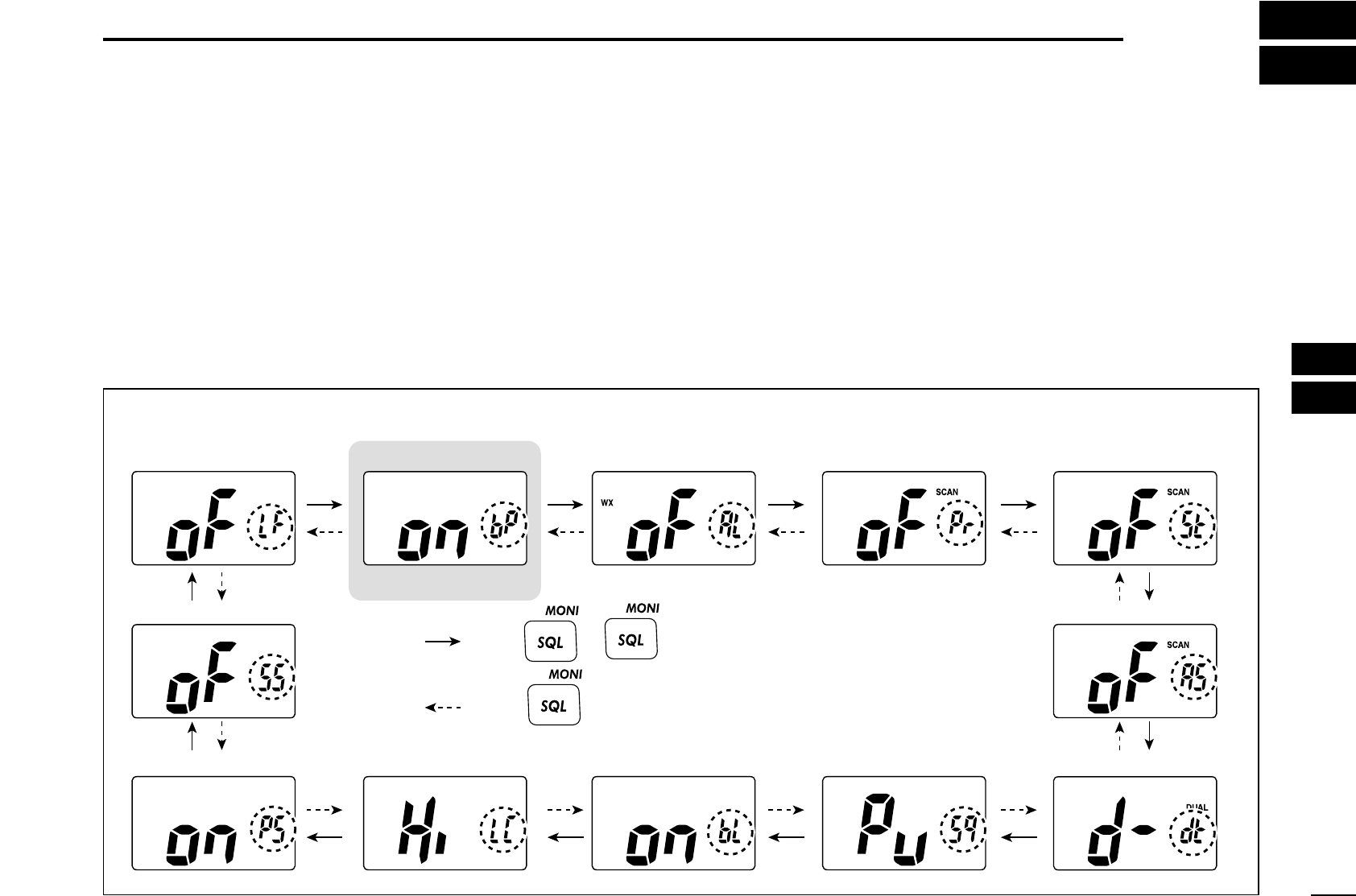
17
7
SET MODE
6
7
■Set mode programming
Set mode is used to change the condition of 12 transceiver
functions: beep tone function, weather alert function, priority
scan function, scan resume timer, auto scan function, dual/tri-
watch function, monitor key action, automatic backlighting,
LCD contrast setting, power save function, squelch sensitivity
and low fix function*.
*Appears only when the optional battery case is attached.
DSet mode operation
qTurn power OFF.
wWhile pushing [SQL], turn power ON to enter set mode.
• “bP” appears.
ePush [SQL] to select the desired item, if necessary.
rPush [Y]/[Z]to select the desired condition of the item.
tTo exit set mode, push [16].
DSET MODE ITEMS (The display shows the default settings, and the selected item is displayed in the dotted circle.)
• Auto scan
Starting item
• Beep tone• Low fix* • Scan resume timer
• Dual/Tri-watch
• Automatic
backlighting
• Power save • LCD contrast • Monitor key action
• Squelch sensitivity
• Priority scan• Weather alert
: Push +[Z]
: Push or +[Y]*Appears only when the optional
battery case is attached.
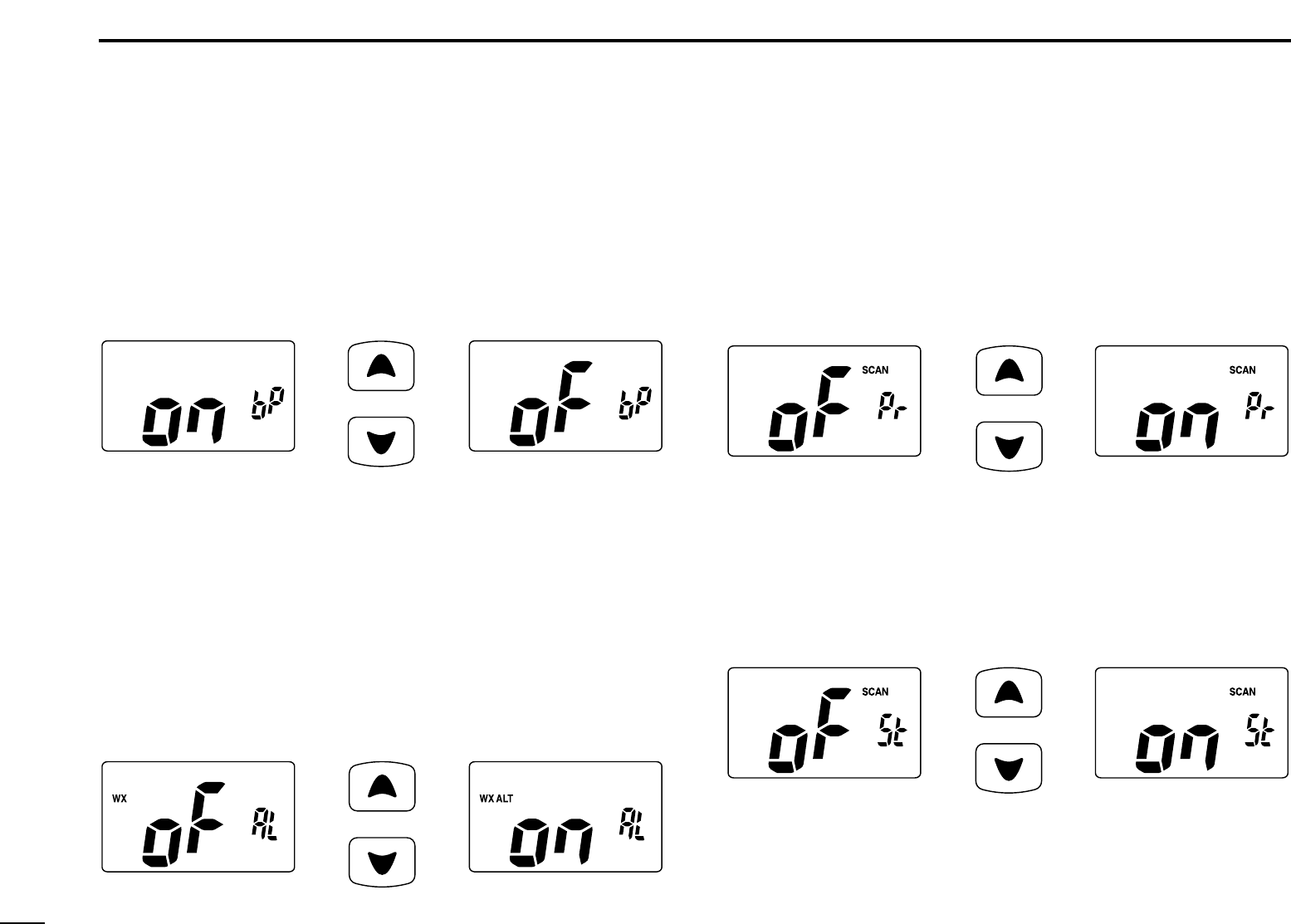
18
7SET MODE
■Set mode items
DBeep tone function “bP”
Select the key touch beep sound ON or US, or turn sound OFF.
• ON : A fixed beep sounds (default)
• US : The preset beeps (e.g. do, re, mi) sound
• OFF: Silent operation
DWeather alert function “AL”
A NOAA broadcast station transmits a weather alert tone be-
fore any important weather announcements. When the
weather alert function is turned ON, any detected weather alert
will make the IC-M34 activate a blinking “WX ALT” on the func-
tion display and repeatedly sound a beep tone. The blinking
and beeping stops when the radio is picked up and operated.
The previously selected weather channel is checked any time,
or while scanning, when the power save function is activated.
•“ALT” appears when the function is set ON.
DPriority scan function “Pr”
The transceiver has 2 scan types— normal (OFF) and priority
(ON) scans. Normal scan searches all TAG channels in the
selected channel group. Priority scan searches all TAG chan-
nels in sequence while monitoring Channel 16.
DScan resume timer “St”
The scan resume timer can be set as a pause (OFF) or timer
scan (ON). When OFF is selected, the scan pauses until a
received signal disappears. When ON is selected, the scan
pauses for 5 sec. after receiving a signal and then resumes
even if the signal has been received.
Push
Scan resume timer OFF
(default)
Scan resume timer ON
Push
Normal scan (default) Priority scan
Push
Weather alert function
OFF (default)
Weather alert function
ON
Push
Beep tone ON (default) Beep tone OFF
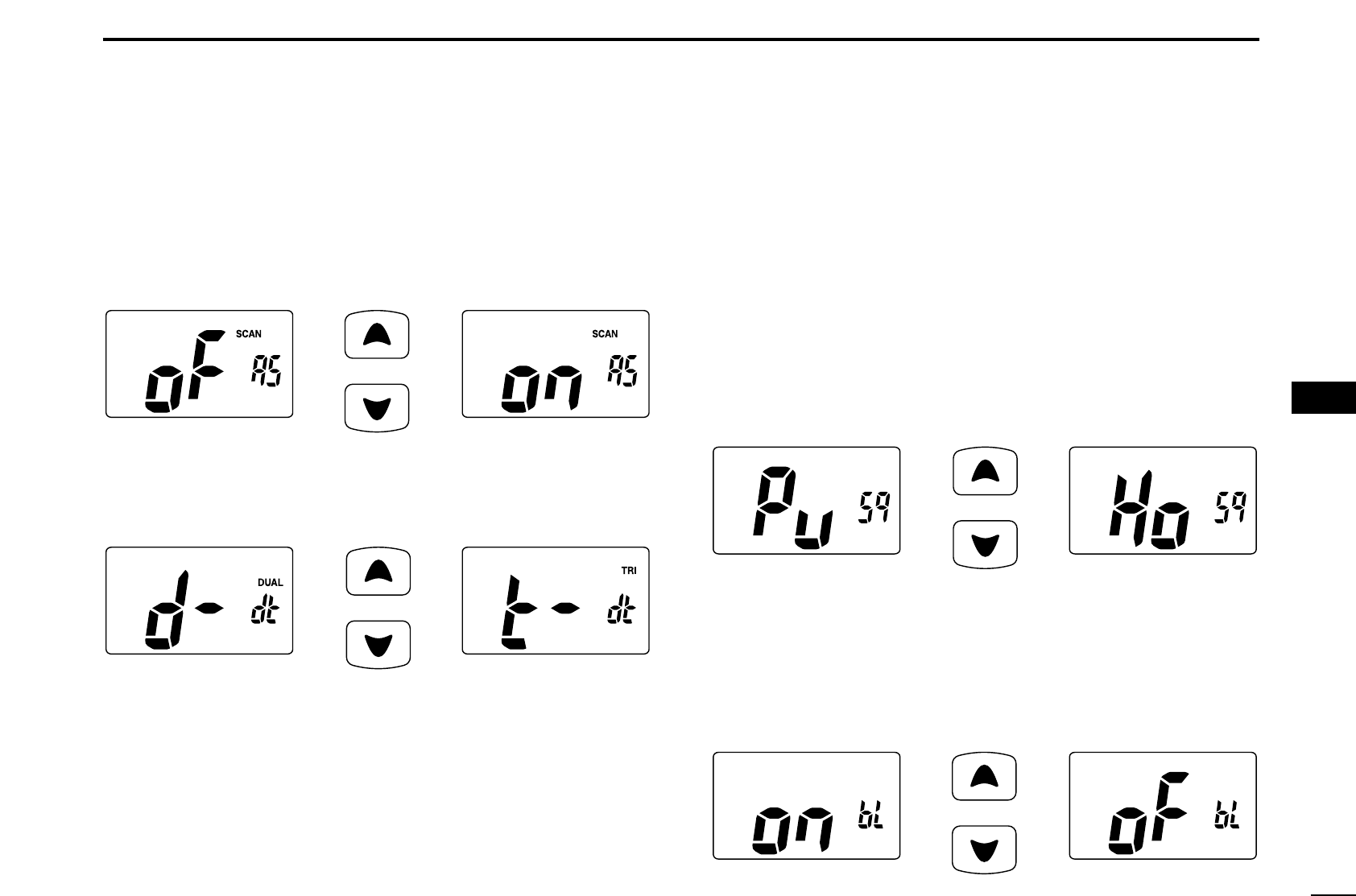
19
7
SET MODE
7
DAuto scan function “AS”
The auto scan function starts the desired scan automatically
when no signal is received, and no operation is performed for
30 sec.
DDual/Tri-watch function “dt”
This item selects dual or tri-watch as desired. See p. 16 for
details.
DMonitor key action “Sq”
The monitor key action cuts off the squelch function tem-
porarily. This key action contains PUSH (Pu) or HOLD (Ho)
settings as shown below.
• Pu (PUSH): After pushing [MONI] (SQL) for 1 sec., the squelch opens
and emits audio. The squelch is held open while contin-
uously pushing and holding [MONI] (SQL). (default)
• Ho (HOLD): After pushing [MONI] (SQL) for 1 sec., the squelch
opens and emits audio even [MONI] (SQL) is released.
To close the squelch, push any key.
DAutomatic Backlighting “bL”
This function is convenient for nighttime operation. The back-
light can be selected from ON and OFF.
• The backlight is automatically activated when any key except for
[PTT] is pushed.
• The backlight is automatically turned OFF after 5 sec. of inactivity.
Push
Auto backlighting ON
(default)
Auto backlighting OFF
Push
Push setting (default) Hold setting
Push
Dualwatch function
(default)
Tri-watch function
Push
Auto scan OFF (default) Auto scan ON
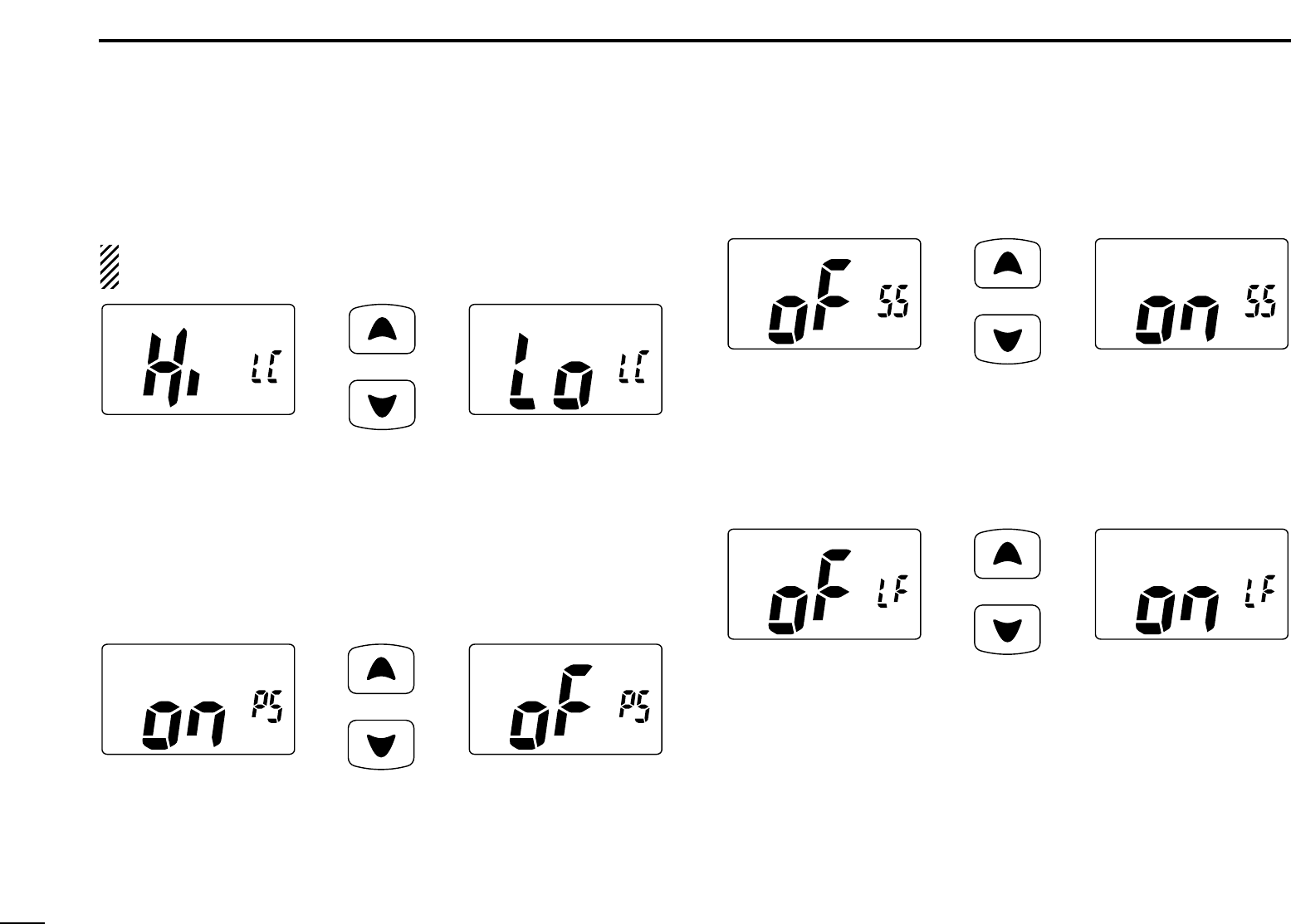
20
7SET MODE
DLCD contrast setting “LC”
Set the LCD contrast level from High contrast or Low con-
trast.
NOTE: The LCD contrast level between High contrast and
Low contrast seems no difference indoors.
DPower save function “PS”
The power save function reduces current drain by deactivat-
ing the receiver circuit for preset intervals.
• ON : The power save function is turned ON. The power save func-
tion will activate when no signal is received, and no opera-
tion is performed for 5 sec.
• OFF : The power save function is turned OFF.
DSquelch sensitivity “SS”
When this function is turned ON, blocking against noise is im-
proved and the squelch is not easily affected by noise.
DLow fix function “LF”
(Appears only when the optional battery case is attached.)
When this function is turned ON, the output power is fixed to
low except for channel 16.
Push
Low fix function
OFF (default)
Low fix function ON
Push
Squelch sensitivity
OFF (default)
Squelch sensitivity
ON
Push
Power save ON
(default)
Power save OFF
Push
High contrast (default) Low contrast
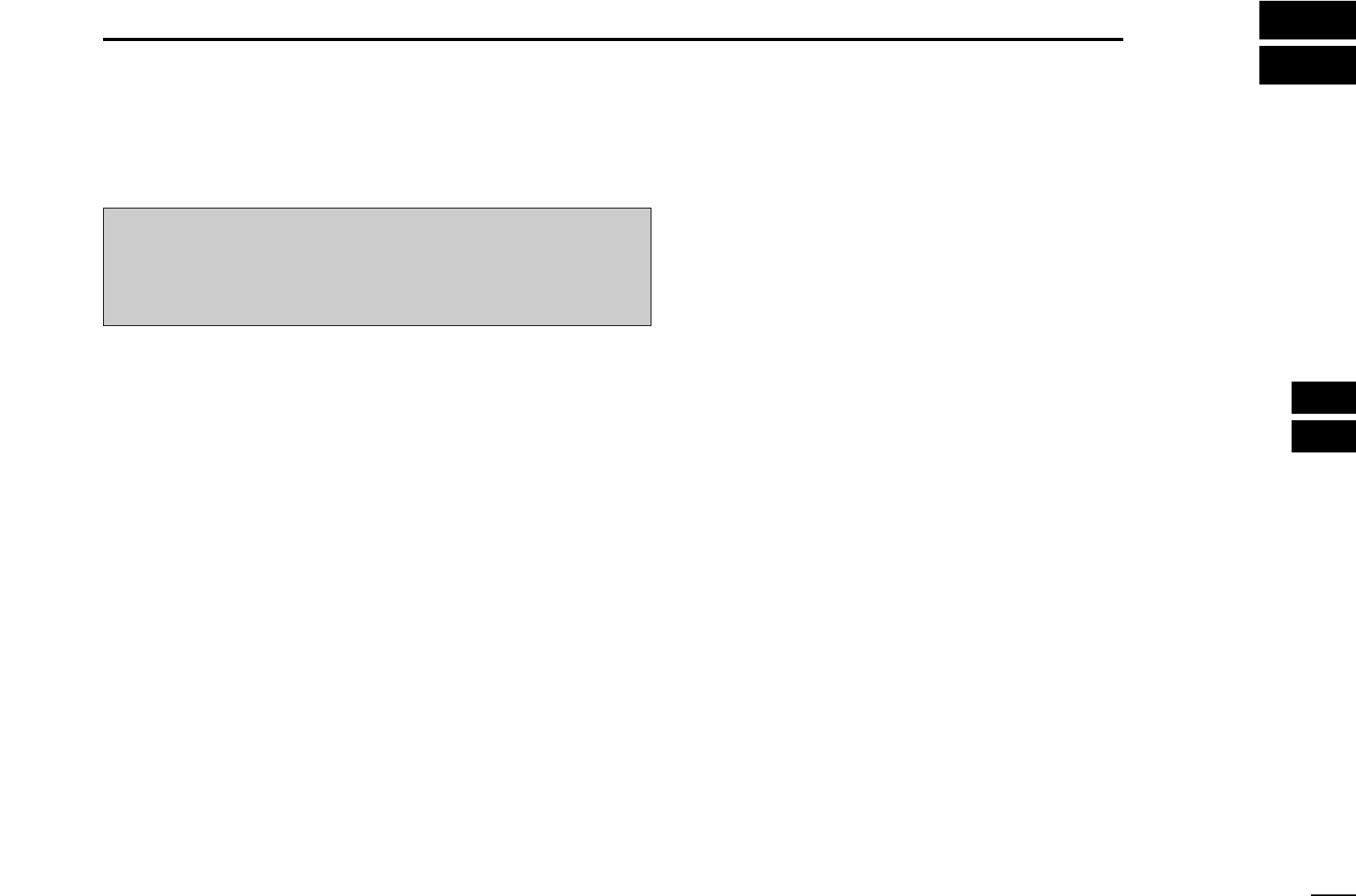
21
8
BATTERY CHARGING
1
2
3
4
5
6
7
8
9
10
11
12
13
14
15
16
■Battery caution
RDANGER! Use and charge only specified Icom battery
pack with Icom radios or Icom charger. Only Icom battery
pack is tested and approved for use and charge with Icom ra-
dios or Icom charger. Using third-party or counterfeit battery
packs or charger may cause smoke, fire, or cause the battery
to burst.
DBattery caution
RDANGER! DO NOT hammer or otherwise impact the bat-
tery. Do not use the battery if it has been severely impacted or
dropped, or if the battery has been subjected to heavy pres-
sure. Battery damage may not be visible on the outside of the
case. Even if the surface of the battery does not show cracks
or any other damage, the cells inside the battery may rupture
or catch fire.
RDANGER! NEVER use or leave battery pack in areas with
temperatures above +60˚C (+140˚F). High temperature
buildup in the battery, such as could occur near fires or
stoves, inside a sun-heated car, or by setting the battery in
direct sunlight may cause the battery to rupture or catch fire.
Excessive temperatures may also degrade battery perfor-
mance or shorten battery life.
RDANGER! DO NOT expose the battery to rain, snow, sea-
water, or any other liquids. Do not charge or use a wet bat-
tery. If the battery gets wet, be sure to wipe it dry before
using. The battery by itself is not waterproof.
RDANGER! NEVER incinerate a used battery pack since
internal battery gas may cause them to rupture or may cause
an explosion.
RDANGER! NEVER solder the battery terminals, or NEVER
modify the battery pack. This may cause heat generation, and
the battery may rupture, emit smoke or catch fire.
RDANGER! Use the battery only with the transceiver for
which it is specified. Never use a battery with any other equip-
ment, or for any purpose that is not specified in this instruction
manual.
RDANGER! If fluid from inside the battery gets in your eyes,
blindness can result. Rinse your eyes with clean water, with-
out rubbing them, and see a doctor immediately.
Misuse of Lithium-Ion batteries may result in the follow-
ing hazards: smoke, fire, or the battery may rupture.
Misuse can also cause damage to the battery or degra-
dation of battery performance.
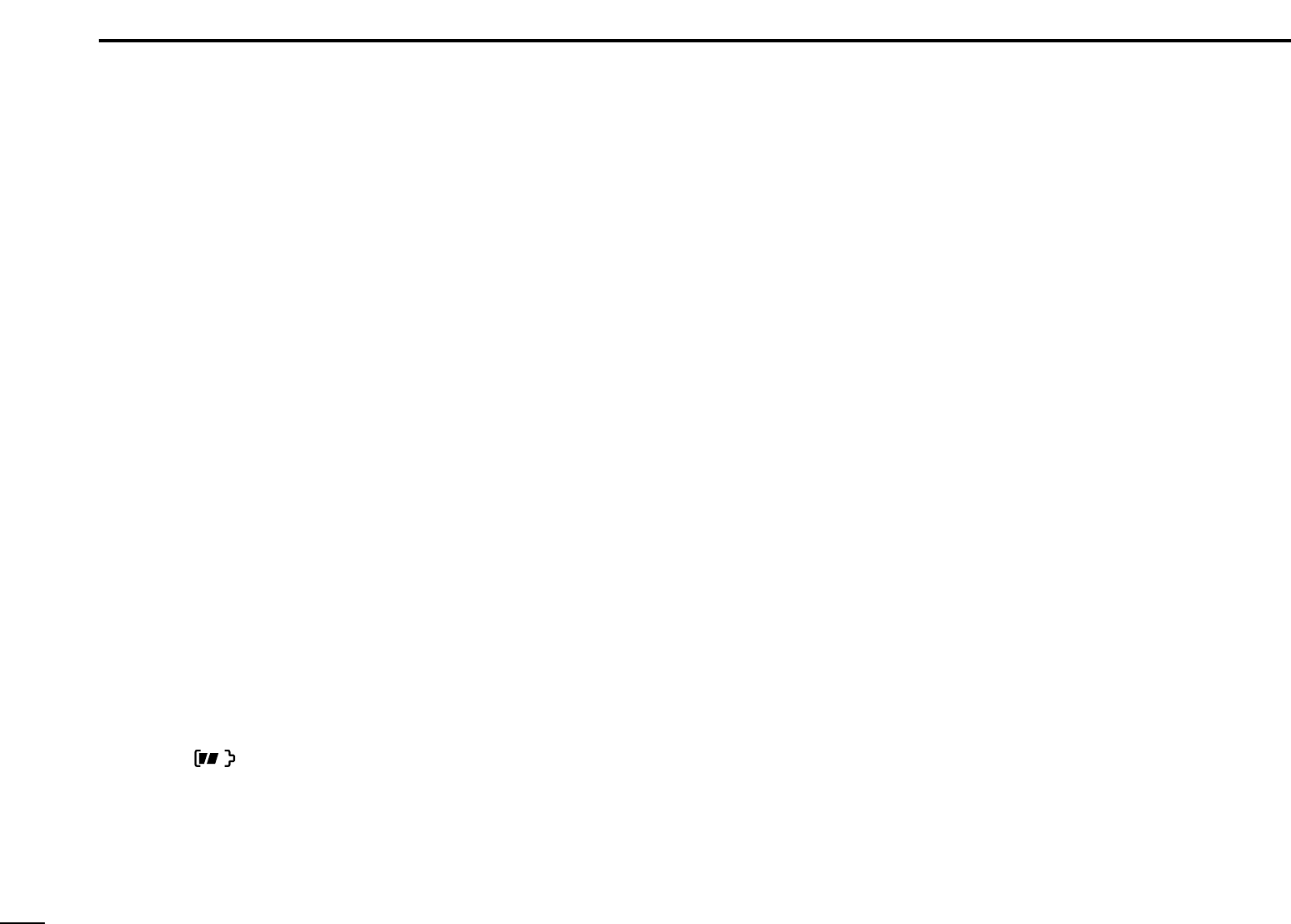
22
8BATTERY CHARGING
WARNING! Immediately stop using the battery if it emits an
abnormal odor, heats up, or is discolored or deformed. If any
of these conditions occur, contact your Icom dealer or distrib-
utor.
WARNING! Immediately wash, using clean water, any part of
the body that comes into contact with fluid from inside the bat-
tery.
WARNING! NEVER put the battery in a microwave oven,
high-pressure container, or in an induction heating cooker.
This could cause overheating, a fire, or cause the battery to
rupture.
CAUTION! Always use the battery within the specified tem-
perature range for the transceiver (–20˚C to +60˚C; –4˚F to
+140˚F) and the battery itself (–20˚C to +60˚C; –4˚F to
+140˚F). Using the battery out of its specified temperature
range will reduce the battery’s performance and battery life.
CAUTION! Shorter battery life could occur if the battery is left
fully charged, completely discharged, or in an excessive tem-
perature environment (above +50˚C; +122˚F) for an extended
period of time. If the battery must be left unused for a long
time, it must be detached from the radio after discharging.
You may use the battery until the battery indicator shows half-
capacity ( ), then keep it safely in a cool dry place with
the temperature between –20˚C to +20˚C (–4˚F to +68˚F).
DCharging caution
RDANGER! NEVER charge the battery pack in areas with
extremely high temperatures, such as near fires or stoves, in-
side a sun-heated car, or in direct sunlight. In such environ-
ments, the safety/protection circuit in the battery will activate,
causing the battery to stop charging.
WARNING! DO NOT charge or leave the battery in the bat-
tery charger beyond the specified time for charging. If the bat-
tery is not completely charged by the specified time, stop
charging and remove the battery from the battery charger.
Continuing to charge the battery beyond the specified time
limit may cause a fire, overheating, or the battery may rup-
ture.
WARNING! NEVER insert the battery and transceiver (bat-
tery attached to the transceiver) into the charger if it is wet or
soiled. This could corrode the battery charger terminals or
damage the charger. The charger is not waterproof.
CAUTION! DO NOT charge the battery outside of the speci-
fied temperature range: ±0˚C to +40˚C (+32˚F to +104˚F).
Icom recommends charging the battery at +20˚C (+68˚F). The
battery may heat up or rupture if charged out of the specified
temperature range. Additionally, battery performance or bat-
tery life may be reduced.
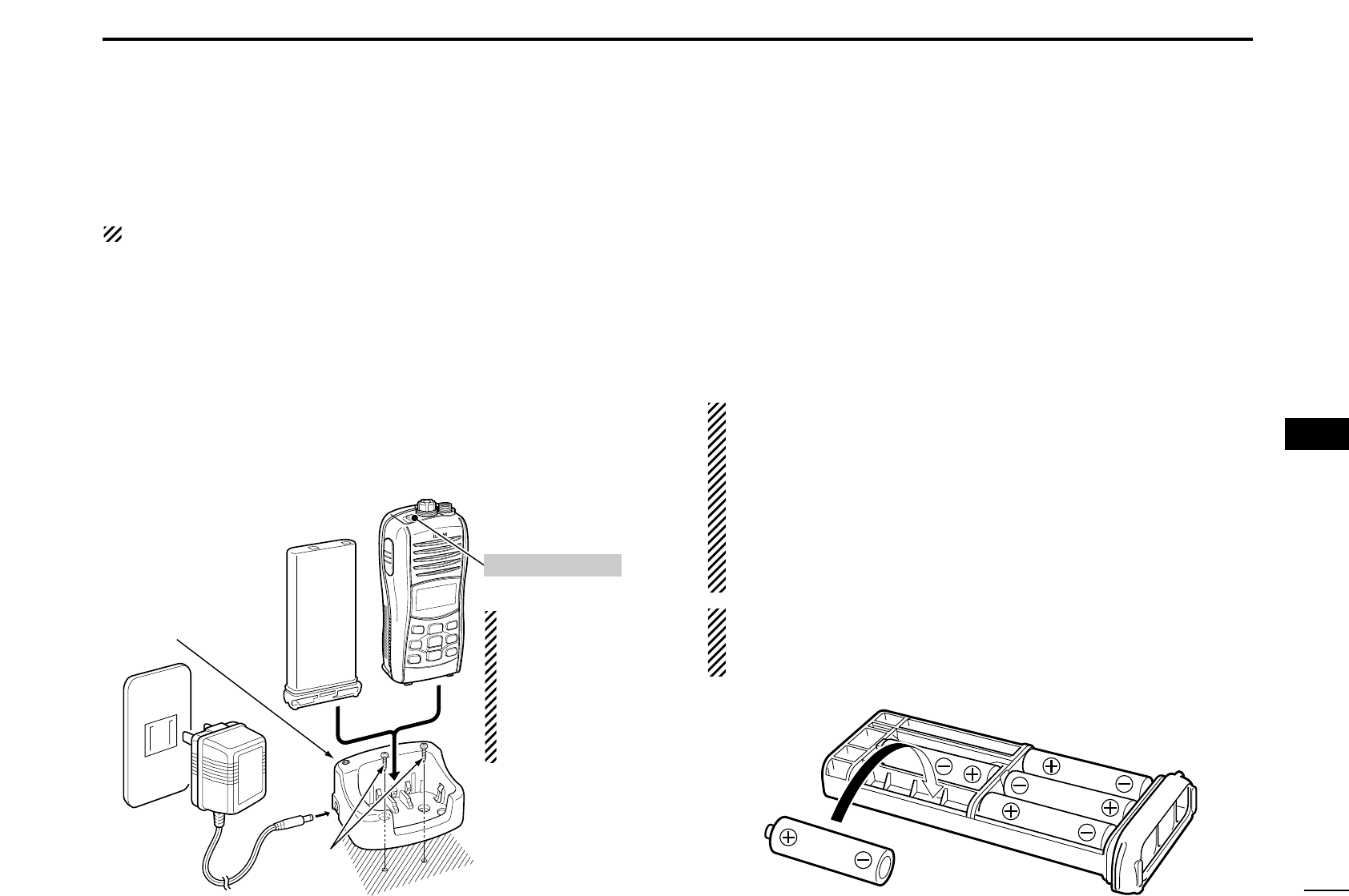
23
8
BATTERY CHARGING
1
2
3
4
5
6
7
8
9
10
11
12
13
14
15
16
■Supplied battery charger
ïCharging connections
NOTE: Do not charge the battery other than BP-252.
qAttach the BC-173 to a flat surface, such as a desk, if desired.
wConnect the AC adapter as shown below.
eInsert the battery pack with/without the transceiver into the
charger.
• The charge indicator lights orange.
• The charge indicator blinks orange (or ogange/green) when the
protector is activated.
rCharge the battery pack approx. 10 hours, depending on
the remaining power condition.
• The charge indicator lights green when charging is completed.
■Optional battery case
When using the optional battery case attached to the trans-
ceiver, install 5 ×AAA(LR03) size alkaline batteries as illus-
trated below.
qRemove the battery case from the transceiver.
wInstall 5 ×AAA(LR03) size alkaline batteries.
• Be sure to observe the correct polarity.
CAUTION:
• When installing batteries, make sure they are all the
same brand, type and capacity. Also, do not mix new and
old batteries together.
• Keep battery contacts clean. It’s a good idea to clean bat-
tery terminals once a week.
• When using the optional battery case, high power output
level is 2 W.
NOTE: The transceiver may sink when the optional battery
case is attached because of the installed alkaline batter-
ies are heavy.
Charge indicator
lights orange when
the battery pack
(with/without the
transceiver) is in-
serted.
BC-173
Supplied
screws
Battery pack Transceiver
AC adapter
Turn power OFF
NOTE: The bat-
tery charger, BC-
173, has charging
timer. The timer
stops the charging
process after 14
hours (approx.).
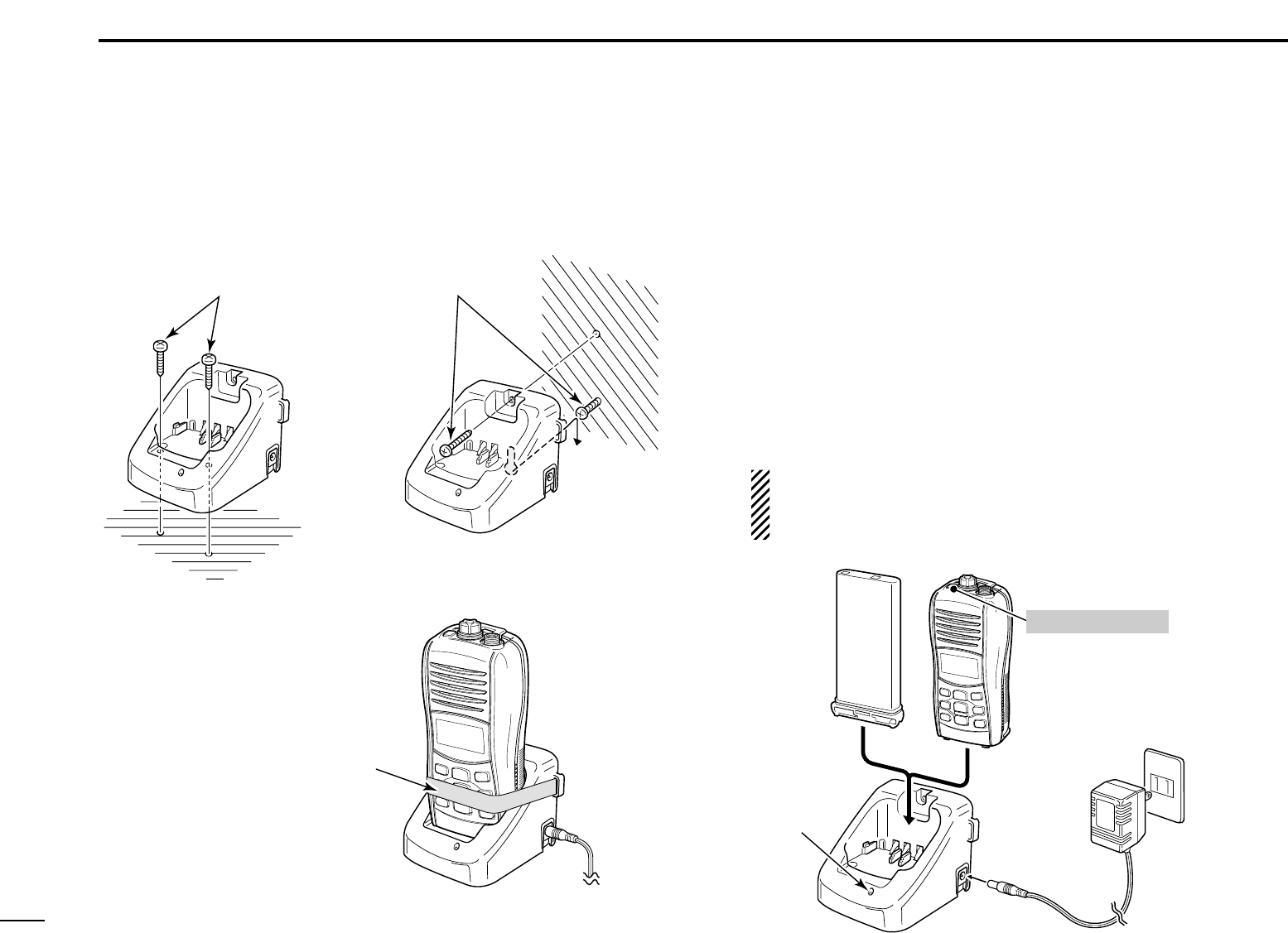
24
8BATTERY CHARGING
■Optional battery charger
DBC-162 installation DCharging
qConnect the AC adapter as shown below.
wInsert the battery pack with/without the transceiver into the
charger.
• The charge indicator lights orange.
• The charge indicator blinks orange (or red) when the protector
is activated.
eCharge the battery pack approx. 2 hours, depending on
the remaining power condition.
• The charge indicator lights green when charging is complete.
NOTE: The battery charger, BC-162, has charging
timer. The timer stops the charging process after 4
hours (approx.).
BC-162
AC adapter
(Optional for
some versions)
Charge
indicator
Turn power OFF
Battery pack Transceiver
Supplied screwsSupplied screws
• To a desktop • To a wall
• For added stability
Eyelet:
Use a rubber band to
secure the transceiver,
if desired.
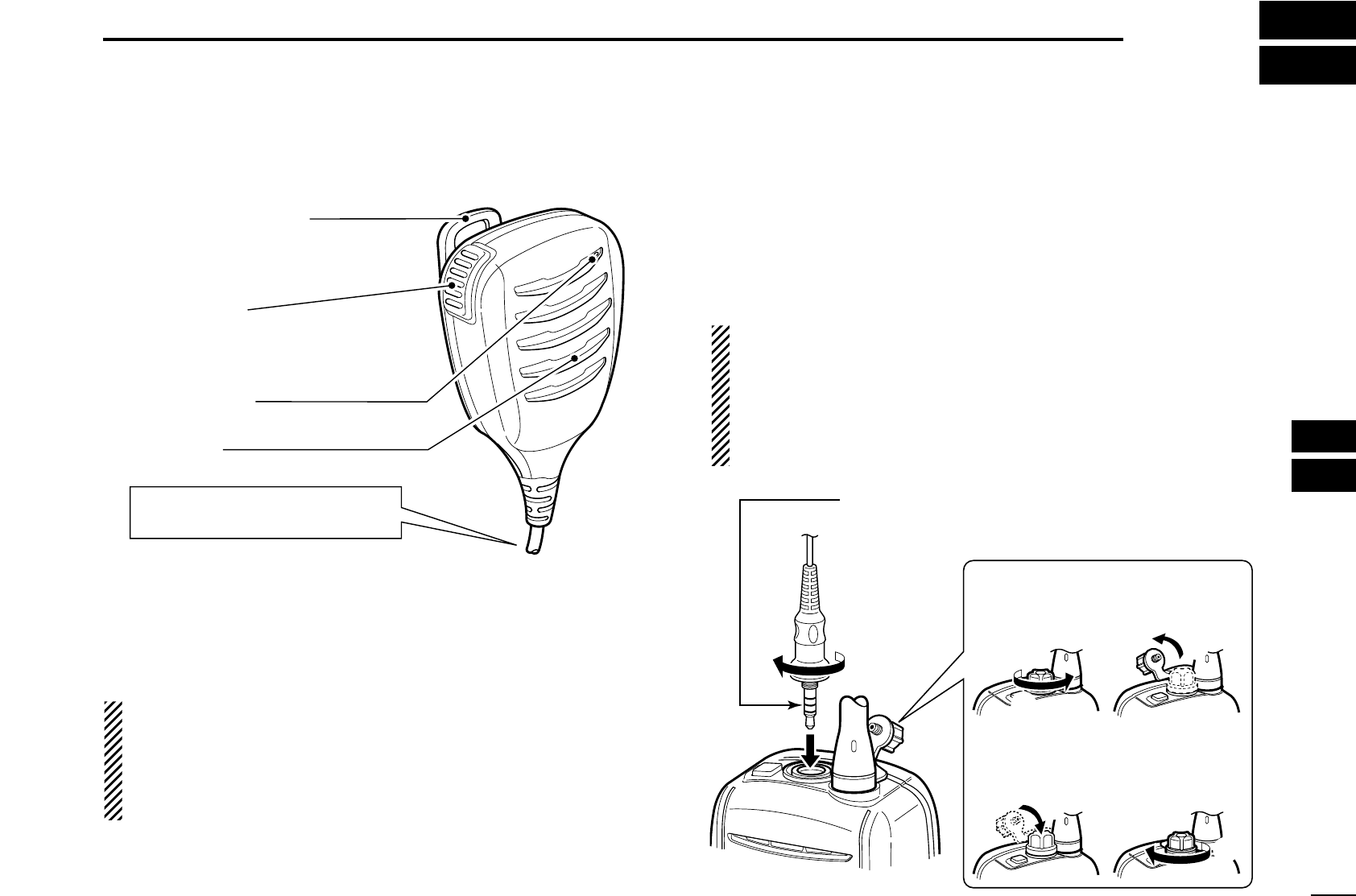
25
9
OPTIONAL SPEAKER-MICROPHONE
1
2
3
4
5
6
7
8
9
10
11
12
13
14
15
16
■HM-165 descriptions
NEVER immerse the connector in water. If the connector be-
comes wet, be sure to dry it BEFORE attaching it to the trans-
ceiver.
NOTE: The microphone is located at the top of the
speaker-microphone, as shown in the diagram above. To
maximize the readability of your transmitted signal (voice),
hold the microphone approx. 2.5 cm (1 inch) from your
mouth, and speak in a normal voice level.
■Attachment
Turn power OFF before attaching the speaker-microphone.
Then, insert the speaker-mic connector onto the [SP MIC]
connector and carefully screw it tight, as shown in the dia-
gram below. Be careful not to cross-thread the connection.
IMPORTANT: KEEP the transceiver’s [SP MIC] connector
cap attached when the speaker-microphone is not in use.
If the cover is not attached, water will get into the trans-
ceiver. Moreover, the terminals (pins) will become rusty, or
the transceiver will function abnormally if the connector has
become wet.
CAUTION: Attach the speaker-microphone’s
connector securely to prevent accidental
dropping, or water intrusion in the connector.
Detaching:
Rotate the [SP MIC] cap counter-
clockwise (q), then detach it (w).
Attaching:
Attach the
[SP MIC]
cap (
q
), then
rotate it clockwise completely (
w
).
q
w
q
w
PTT switch
Transmits during push.
Receives during release.
Microphone
Speaker
Alligator type clip
To attach the speaker-mic.
to your shirt or collar, etc.
Turn the transceiver power OFF
when connecting the HM-165.
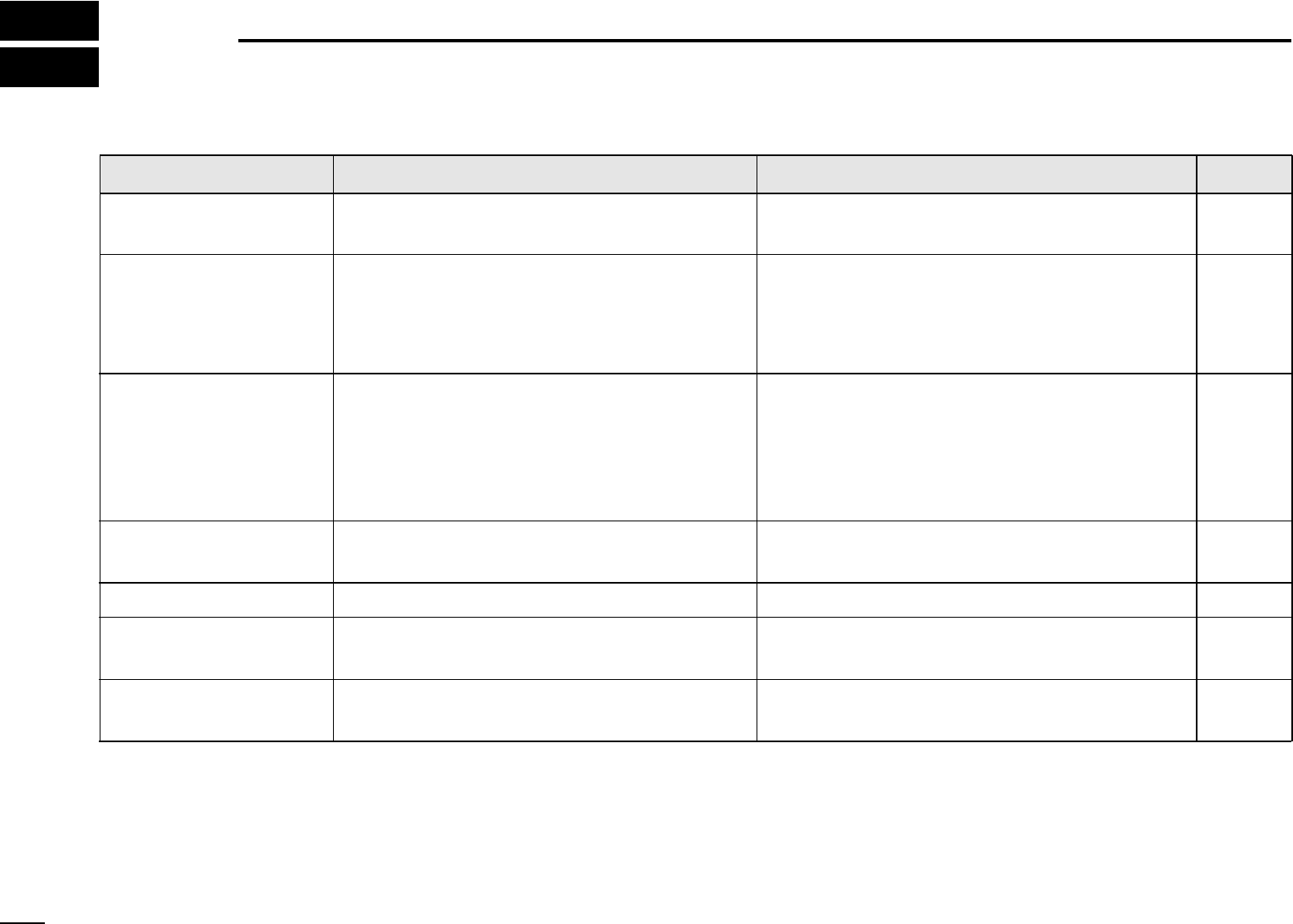
26
TROUBLESHOOTING
10
PROBLEM POSSIBLE CAUSE SOLUTION REF.
No sound from speaker. • Squelch level is too deep.
• Volume level is too low.
• Speaker has been exposed to water.
p. 12
p. 11
—
• Set squelch to the threshold point.
• Push [Y]/[Z]after pushing [VOL] to set a
suitable level.
• Drain water from the speaker.
The transceiver does
not turn ON.
• The battery is exhausted.
• The battery pack is not attached correctly.
p. 21
p. 3
• Recharge the battery pack.
• Attach the battery pack correctly.
Transmitting is impossi-
ble, or high power can
not be selected.
• Some channels are for low power or re-
ceive only.
• The battery is exhausted.
• The battery over charged.
• The output power is set to low.
pgs. 8,
9, 21
p. 21
—
p. 10
• Change channels.
• Recharge the battery pack.
• Verify the battery voltage is correct.
• Push [H/L] to select high power.
The displayed channel
cannot be changed.
• Lock function is activated. • Push and hold [LOCK] (H/L) for 1 sec. to
cancel the function.
p. 12
Scan does not start. • “TAG” channels are not programmed. • Set the desired channels as “TAG” channels. p. 15
No beeps. • Beep tones are turned OFF. • Set the beep tones to ON (Fix Beep/User
Beep) in set mode.
p. 18
Battery voltage error • The connected battery pack’s voltage is
more than 11 V.
• Verify the battery voltage is correct. —
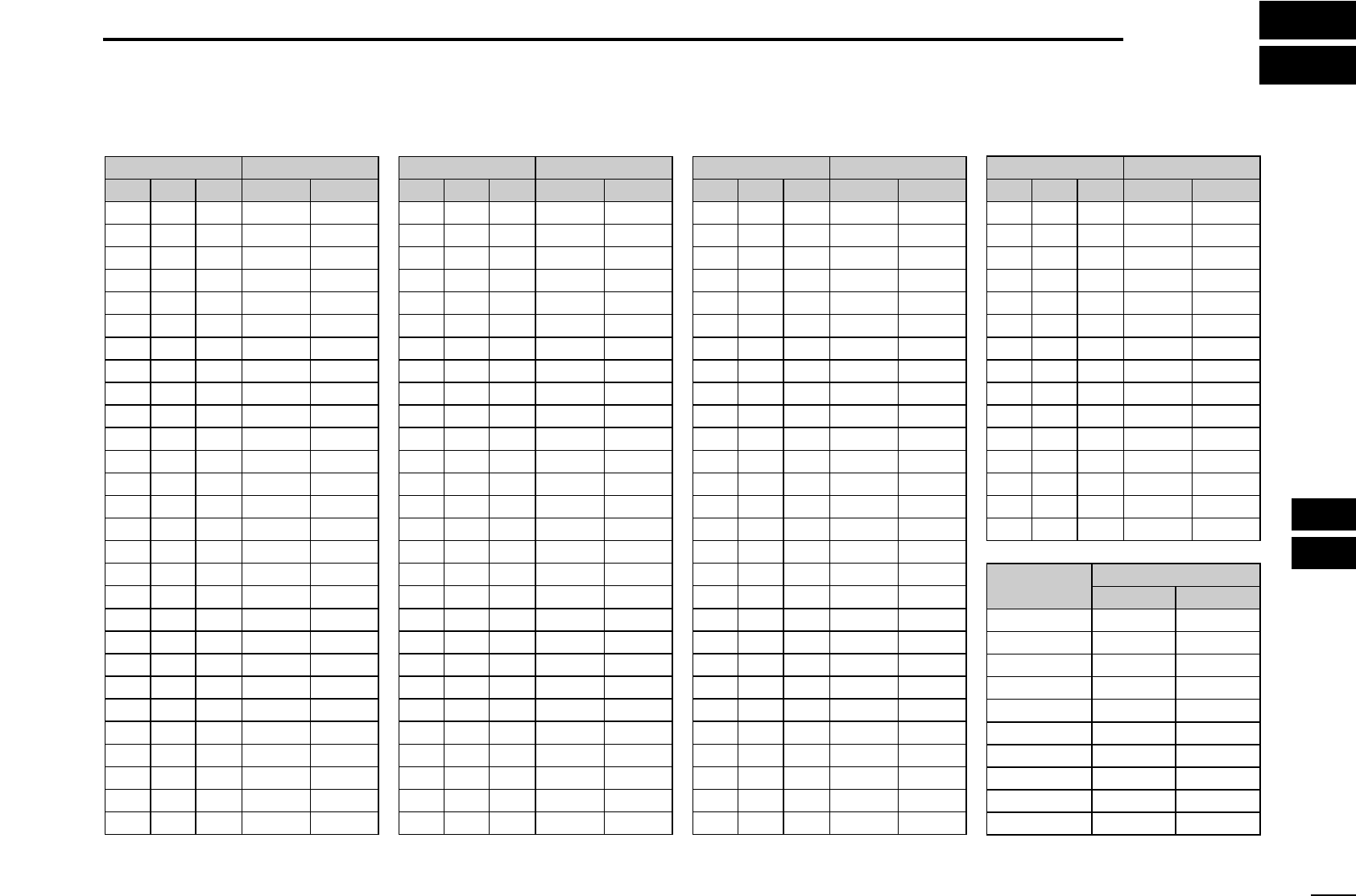
27
11
VHF MARINE CHANNEL LIST
1
2
3
4
5
6
7
8
9
10
11
12
13
14
15
16
NOTE: Simplex channels, 3, 21, 23, 61, 64, 81, 82 and 83 CANNOT
be lawfully used by the general public in U.S.A. waters.
*Low power only.
Channel number Frequency (MHz)
03 156.150 160.75003
03A 156.150 156.150
156.200 160.80004
02 156.100 160.70002
04A 156.200 156.200
156.250 160.85005
05A 05A 156.250 156.250
06 06 156.300 156.30006
156.350 160.95007
07A 07A 156.350 156.350
08 08 156.400 156.40008
09 09 156.450 156.45009
10 10 156.500 156.50010
11 11 156.550 156.55011
12 12 156.600 156.60012
13* 13*
156.650 156.650
13
14 14
156.700 156.700
14
15* 15*
156.750 156.750
15*
16 16
156.800 156.800
16
17* 17*
156.850 156.850
17
156.900 161.500
18
18A 18A
156.900 156.900
156.950 161.550
19
19A 19A 156.950 156.950
20 20* 157.000 161.60020
20A 157.000 157.000
01A 156.050 156.050
USA
01
156.050 160.65001
CAN
Transmit Receive
INT
Channel number Frequency (MHz)
157.100 161.70022
22A 22A 157.100 157.100
23 157.150 161.75023
21b Rx only 161.650
23A 157.150 157.150
24 24 157.200 161.80024
25 25 157.250 161.85025
25b Rx only 161.850
26 26 157.300 161.90026
27 27 157.350 161.95027
28 28 157.400 162.00028
28b Rx only 162.000
60 156.025 160.62560
156.075 160.67561
61A 61A 156.075 156.075
156.125 160.72562
62A 156.125 156.125
156.175 160.77563
63A 156.175 156.175
64 156.225 160.82564
64A 64A 156.225 156.225
156.275 160.87565
65A 65A 156.275 156.27565A
156.325 160.92566
66A 66A* 156.325 156.32566A
67* 67 156.375 156.37567
21A 21A 157.050 157.050
USA
21 157.050 161.65021
CAN
Transmit Receive
INT
Channel number Frequency (MHz)
71 71 156.575 156.57571
72 72 156.625 156.62572
73 73 156.675 156.67573
70 70 RX only 156.52570
74 74 156.725 156.72574
75* 75* 156.775 156.77575*
76* 76* 156.825 156.82576*
77* 77* 156.875 156.87577
156.925 161.52578
78A 78A 156.925 156.925
156.975 161.57579
79A 79A 156.975 156.975
157.025 161.62580
80A 80A 157.025 157.025
157.075 161.67581
81A 81A 157.075 157.075
157.125 161.72582
82A 82A 157.125 157.125
83 157.175 161.77583
83A 83A 157.175 157.175
83b Rx only 161.775
84 84 157.225 161.82584
84A 157.225 157.225
85 85 157.275 161.87585
85A 157.275 157.275
86 86 157.325 161.92586
69 69 156.475 156.47569
68
USA
68 156.425 156.42568
CAN
Transmit Receive
INT
Channel number Frequency (MHz)
88 88 157.425 162.02588
88A 157.425 157.425
87A 157.375 157.375
87 87 157.375 161.97587
86A
USA
157.325 157.325
CAN
Transmit Receive
INT
Frequency (MHz)
RX only 162.425
RX only 162.450
RX only 162.500
RX only 162.475
RX only 162.525
RX only 161.650
RX only 161.775
RX only 163.275
RX only 162.400
RX only 162.550
Transmit Receive
WX channel
4
5
6
3
7
8
9
10
2
1
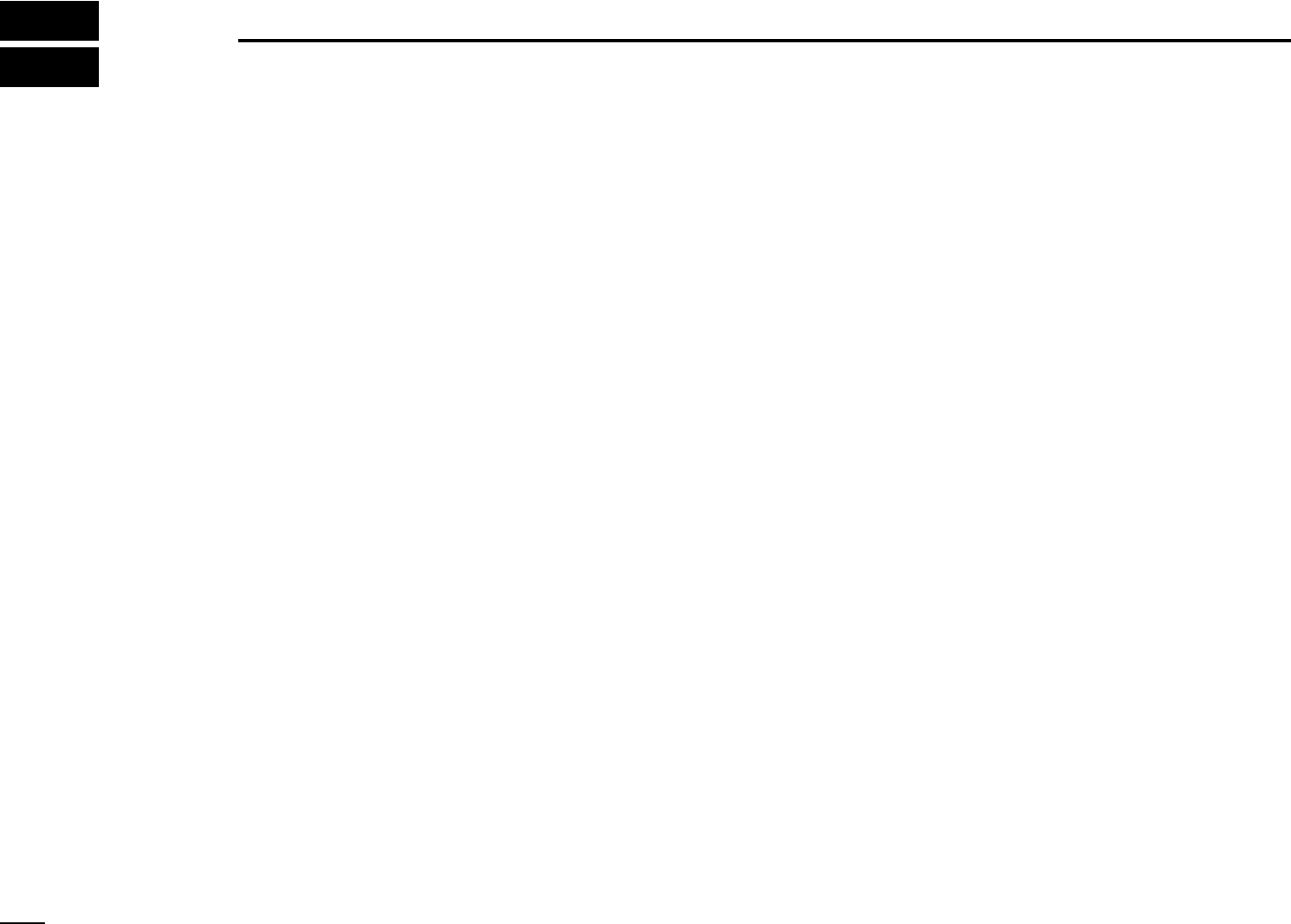
28
SPECIFICATIONS
12
ïGENERAL
• Frequency coverage : Transmit 156.025–157.425 MHz
Receive 156.050–163.275 MHz
• Mode : FM (16K0G3E)
• Channel spacing : 25 kHz
• Power supply requirement : BP-251 and BP-252 only
• Current drain (at 7.4 V DC) : TX High (5 W) 1.5 A
TX Low (1 W) 0.7 A
Max. audio 0.2 A
Power save 20 mA typical
• Frequency stability : ±10 ppm (–20°C to +60°C)
• Useable temperature range : –20°C to +60°C; –4°F to +140°F
• Dimensions : 62 (W) ×141.5(H) ×43(D) mm
(Projections not included) 27⁄16(W) ×59⁄16(H) ×111⁄16(D) inch
• Weight : Approx. 305 g (10.7 oz)
(with BP-252, FA-SC58V and MB-109)
ïTRANSMITTER
• Output power (at 7.7 V DC) : 5 W (High) and 1 W (Low)
• Modulation system : Variable reactance frequency
modulation
• Max. frequency deviation : ±5 kHz
• Adjacent channel power : 70 dB
• Spurious emissions : –68 dBc typical
ïRECEIVER
• Receive system : Double-conversion
superheterodyne
• Sensitivity (12 dB SINAD) : 0.25 µV typical
• Squelch sensitivity : 0.35 µV typical (at threshold)
• Intermodulation rejection ratio : 70 dB typical
• Spurious response rejection ratio : 70 dB typical
• Adjacent channel selectivity : 70 dB typical
• Audio output power : 0.35 W typical at 10% distortion
with an 8 Ωload
All stated specifications are subject to change without notice or
obligation.
4

29
13
OPTIONS
1
2
3
4
5
6
7
8
9
10
11
12
13
14
15
16
DBATTERY CASE AND PACK
• BP-251
BATTERY CASE
Battery case for 5 ×AAA (LR03) alkaline cells.
Output power: 2 W
• BP-252
L
i-Ion
BATTERY PACK
7.4 V/980 mAh Li-Ion battery pack.
DCHARGERS
• BC-173
DESKTOP CHARGER
+ BC-174A/E
AC ADAPTER
Used for regular charging of battery pack. An AC adapter is supplied
with the charger depending on versions.
Charging time: approx. 10 hours
• BC-162
DESKTOP CHARGER
+ BC-145*
AC ADAPTER
Used for rapid charging of battery pack.
Charging time: approx. 2 hours.
*Not supplied with some versions.
DBELT CLIPS
• MB-109
BELT CLIP
The same as supplied with the transceiver.
DOTHER OPTIONS
• HM-165
SPEAKER
-
MICROPHONE
Full sized waterproof (IPX7; 1m/30 min.) speaker-microphone. In-
cludes an alligator clip to attach the speaker mic to your shirt, collar,
etc.
• FA-SC58V
ANTENNA FOR IC
-
M
34
150–174 MHz
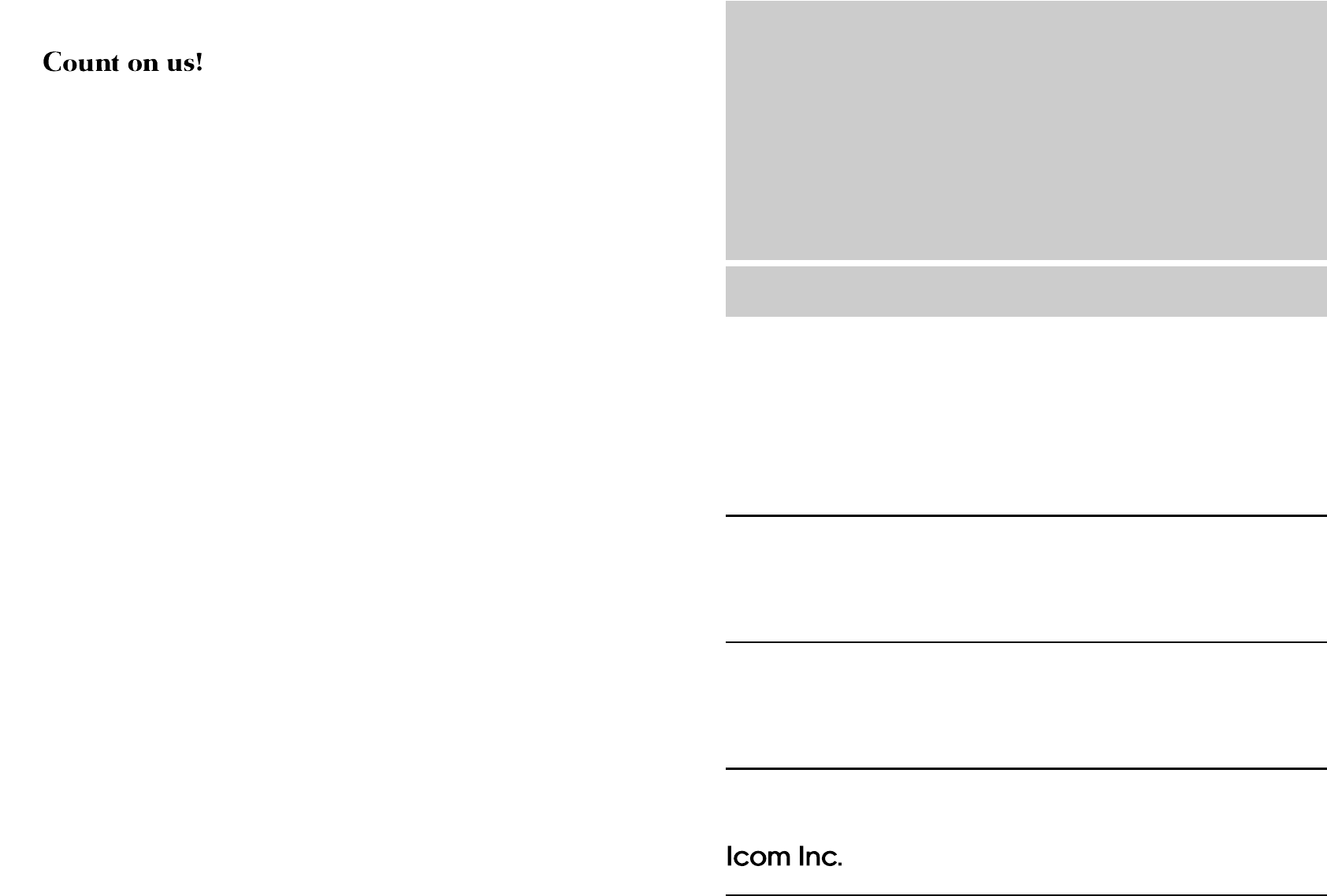
1-1-32 Kamiminami, Hirano-ku, Osaka 547-0003, Japan
A-6544H-1EX
Printed in Japan
©2006 Icom Inc.